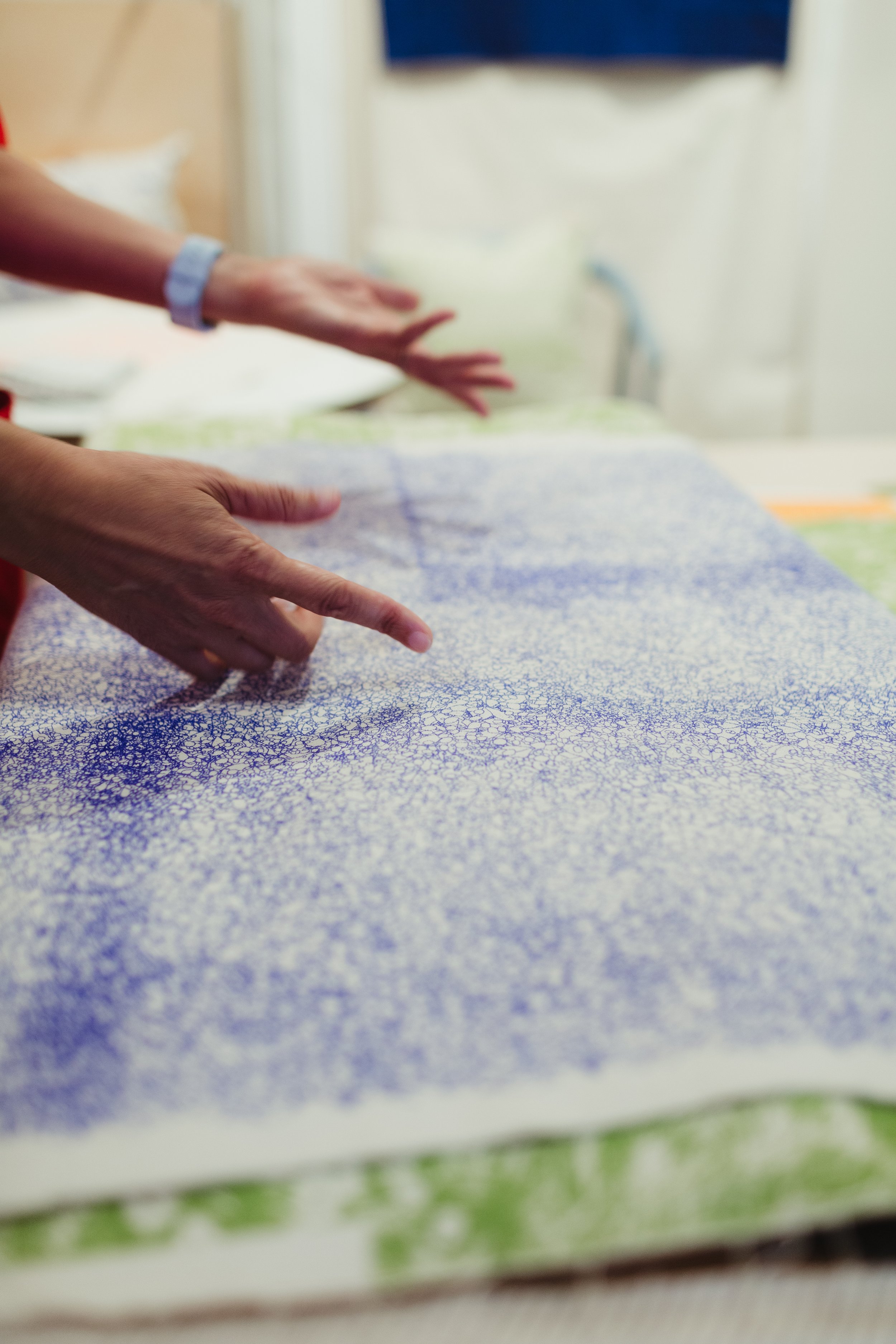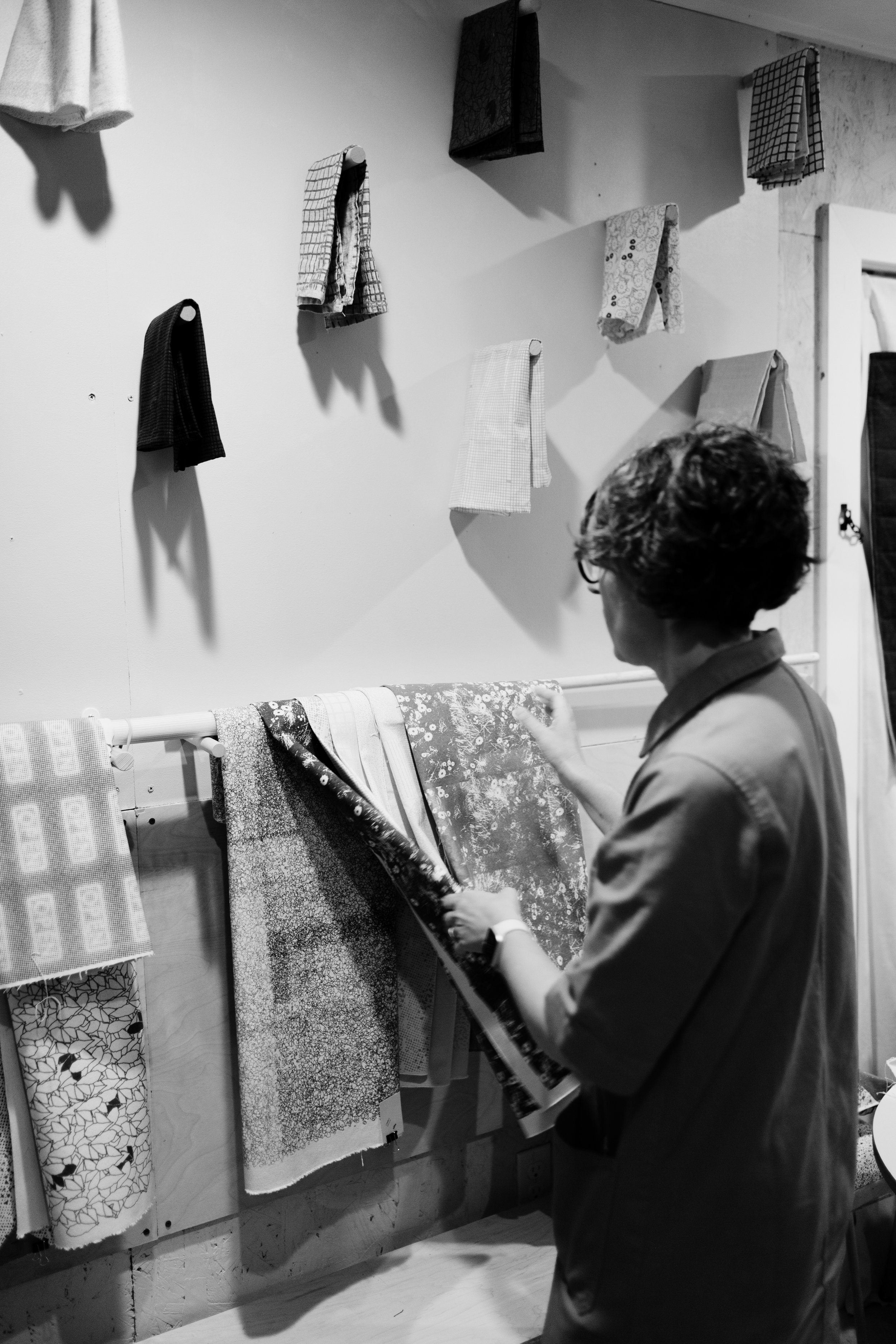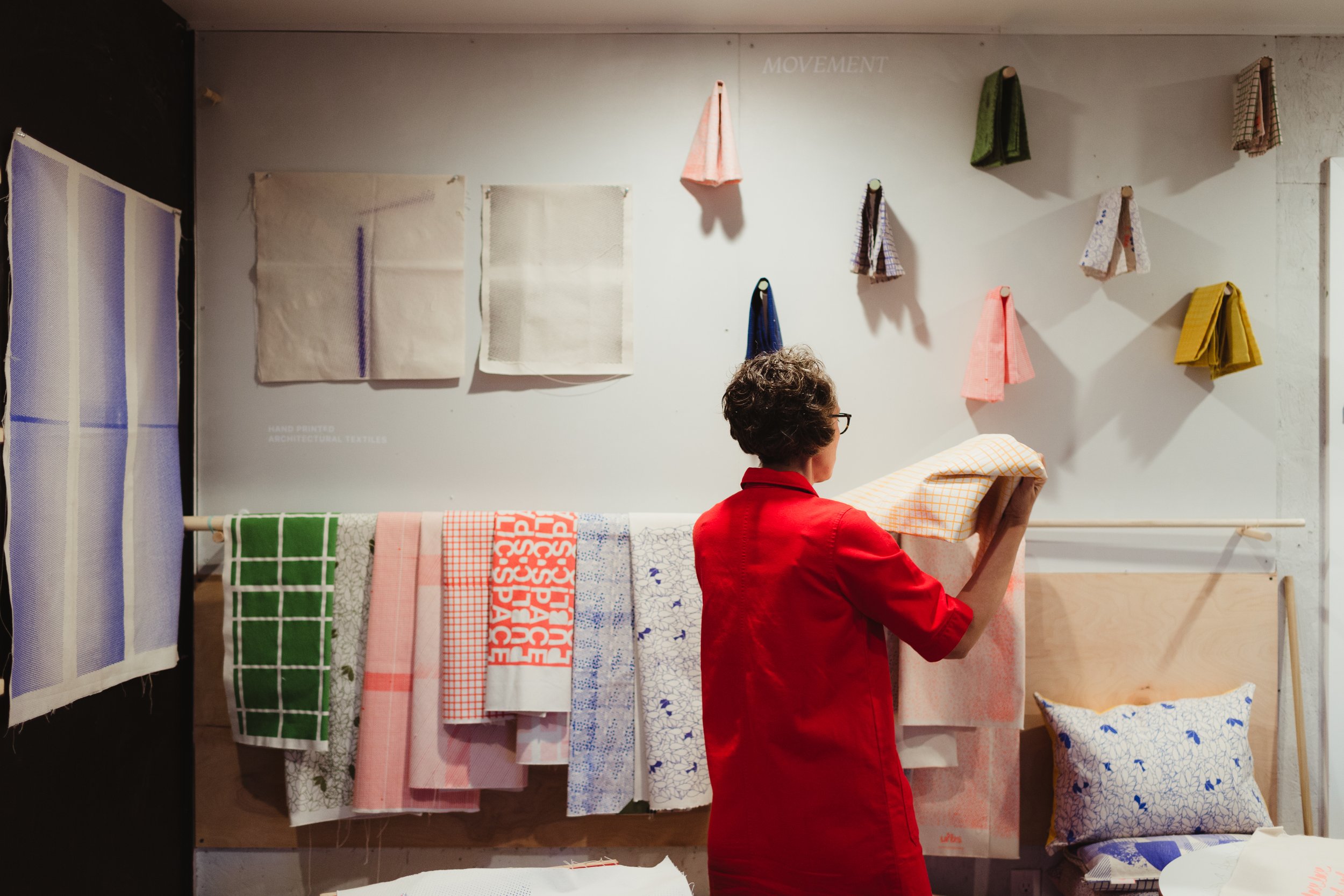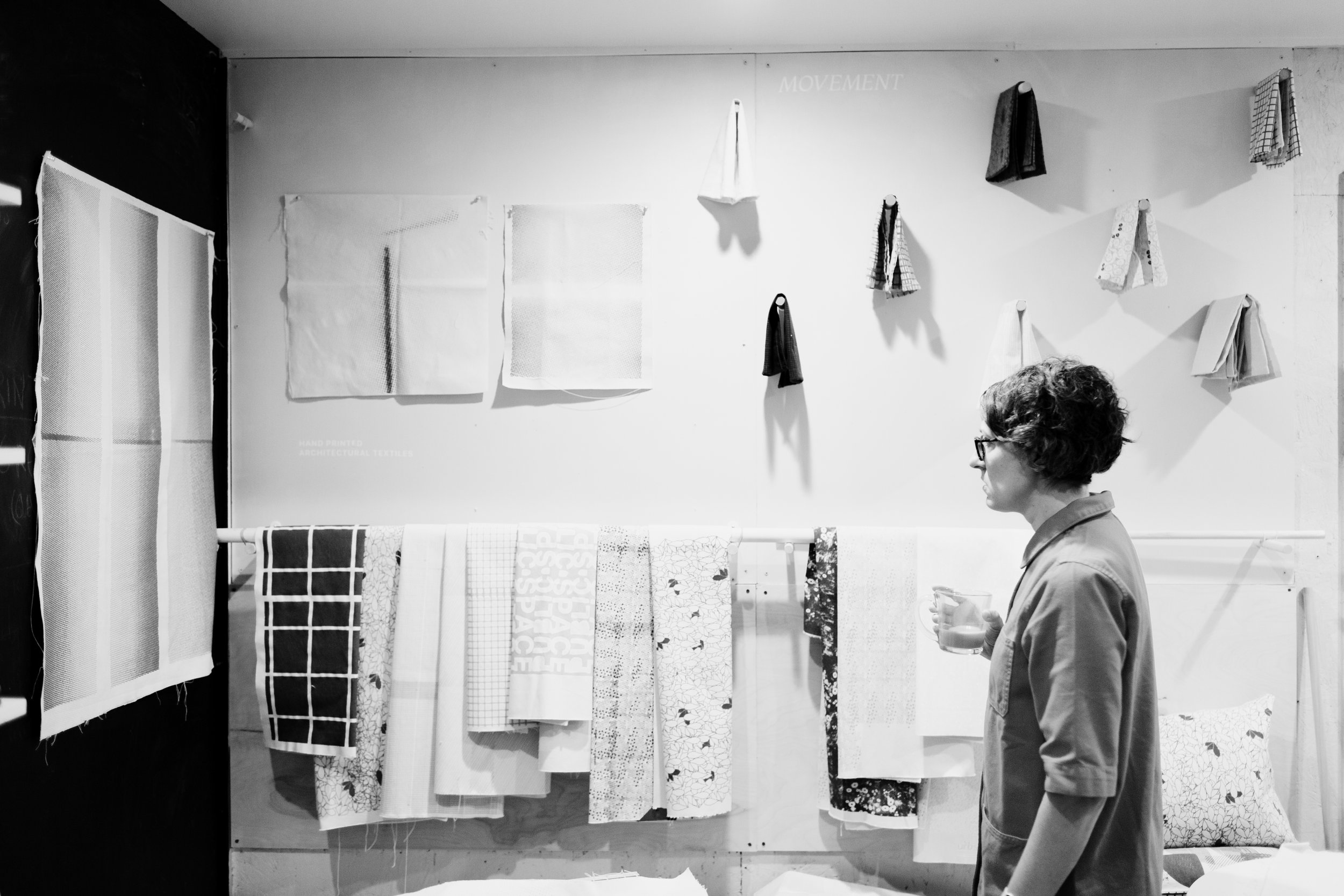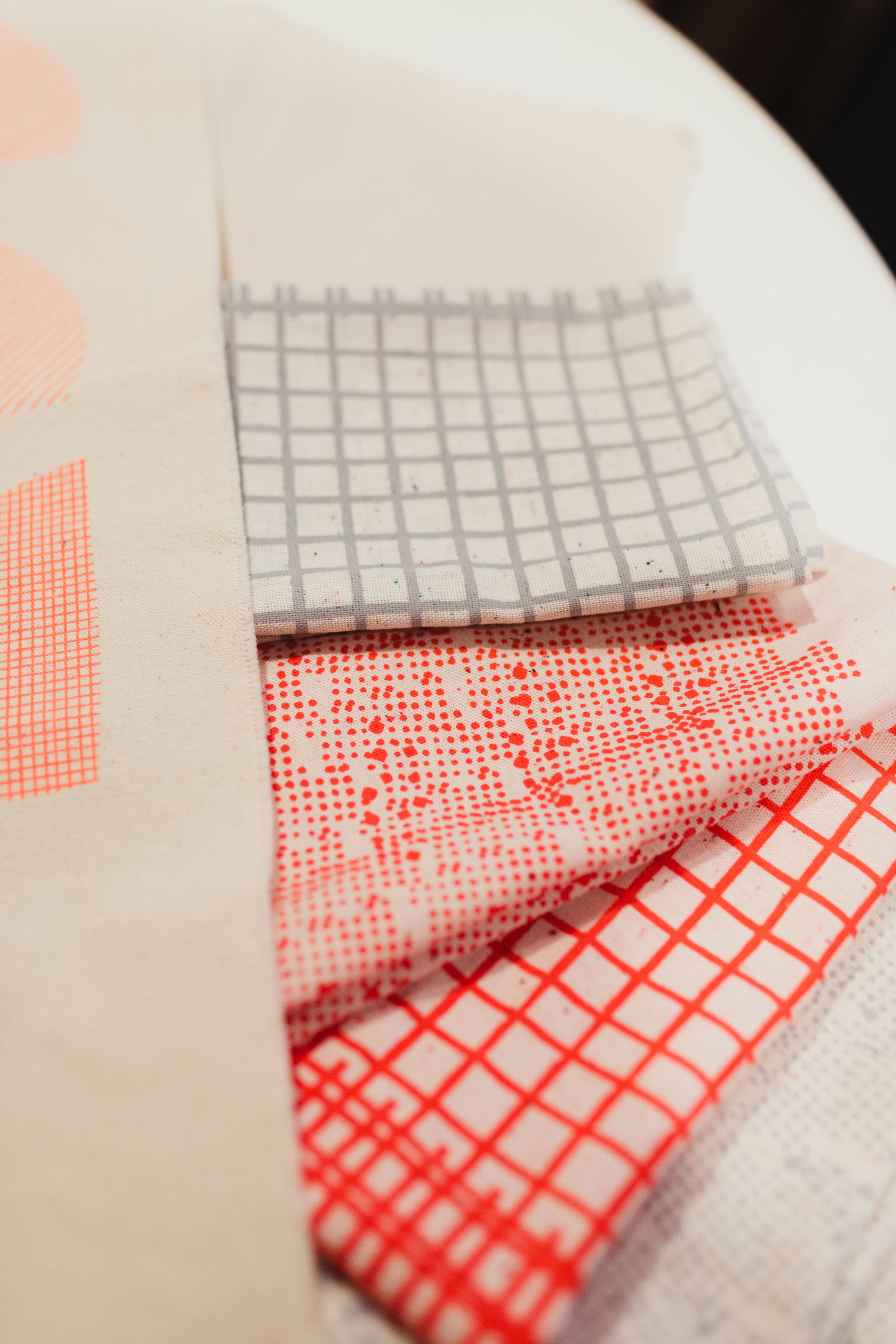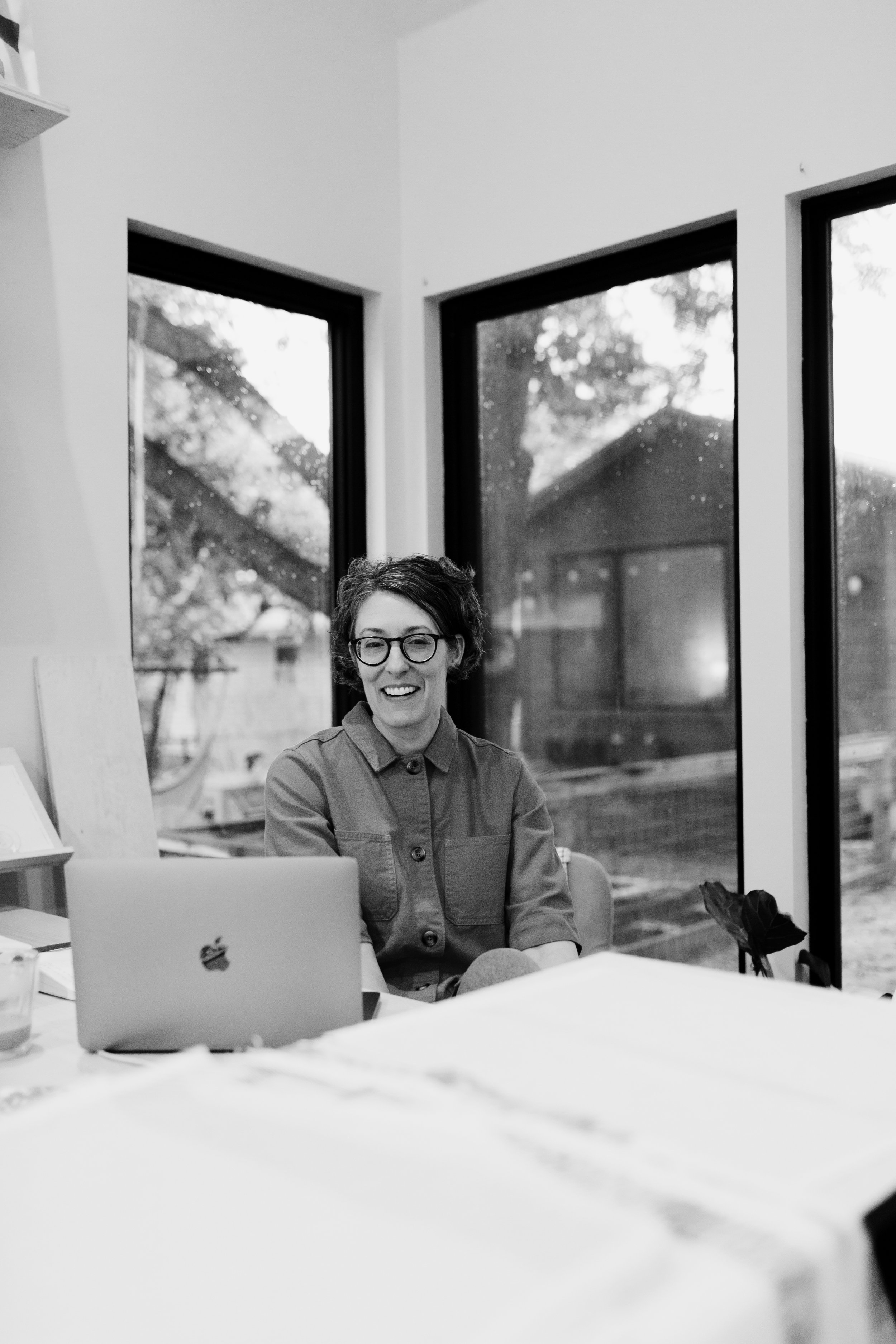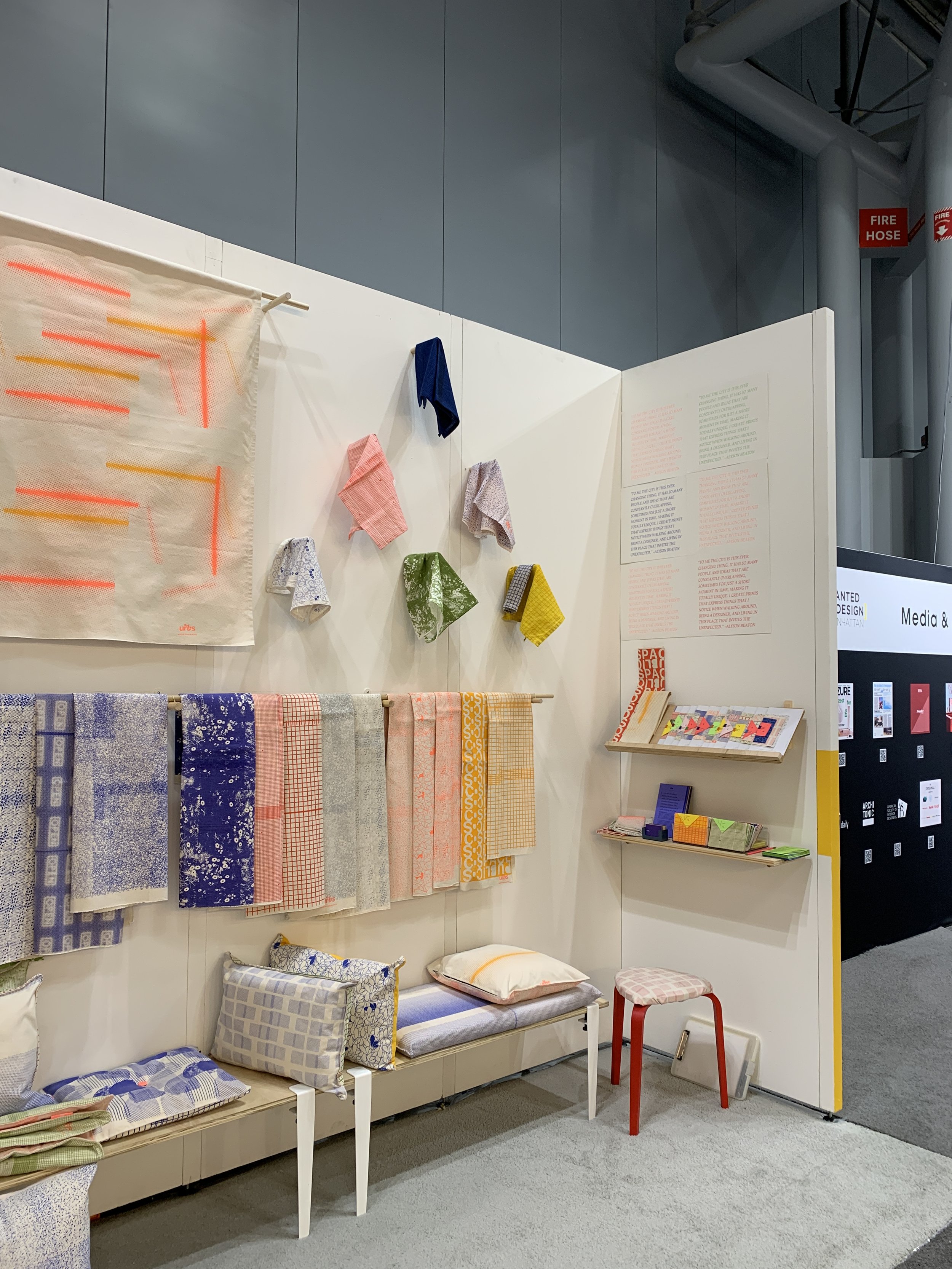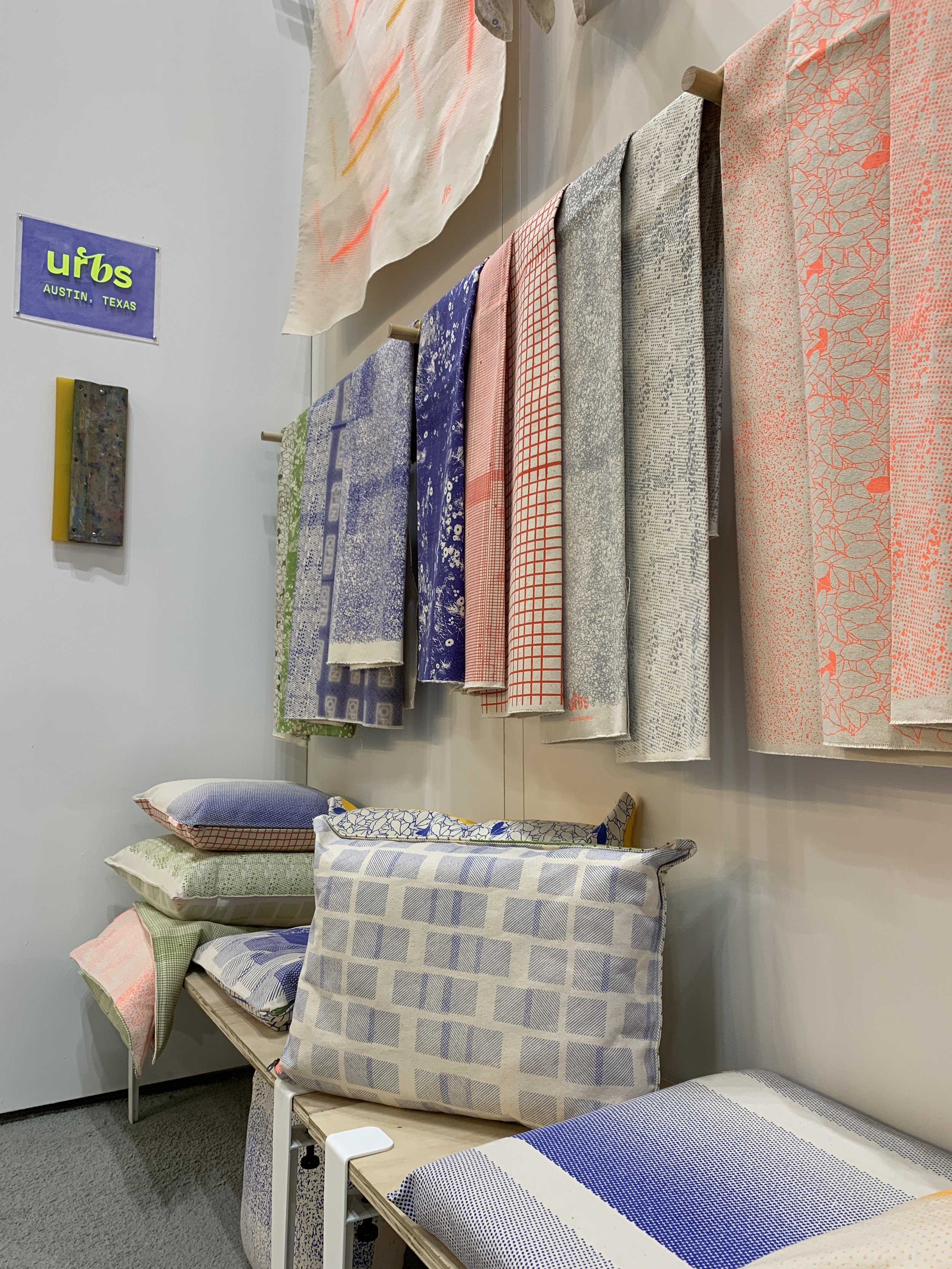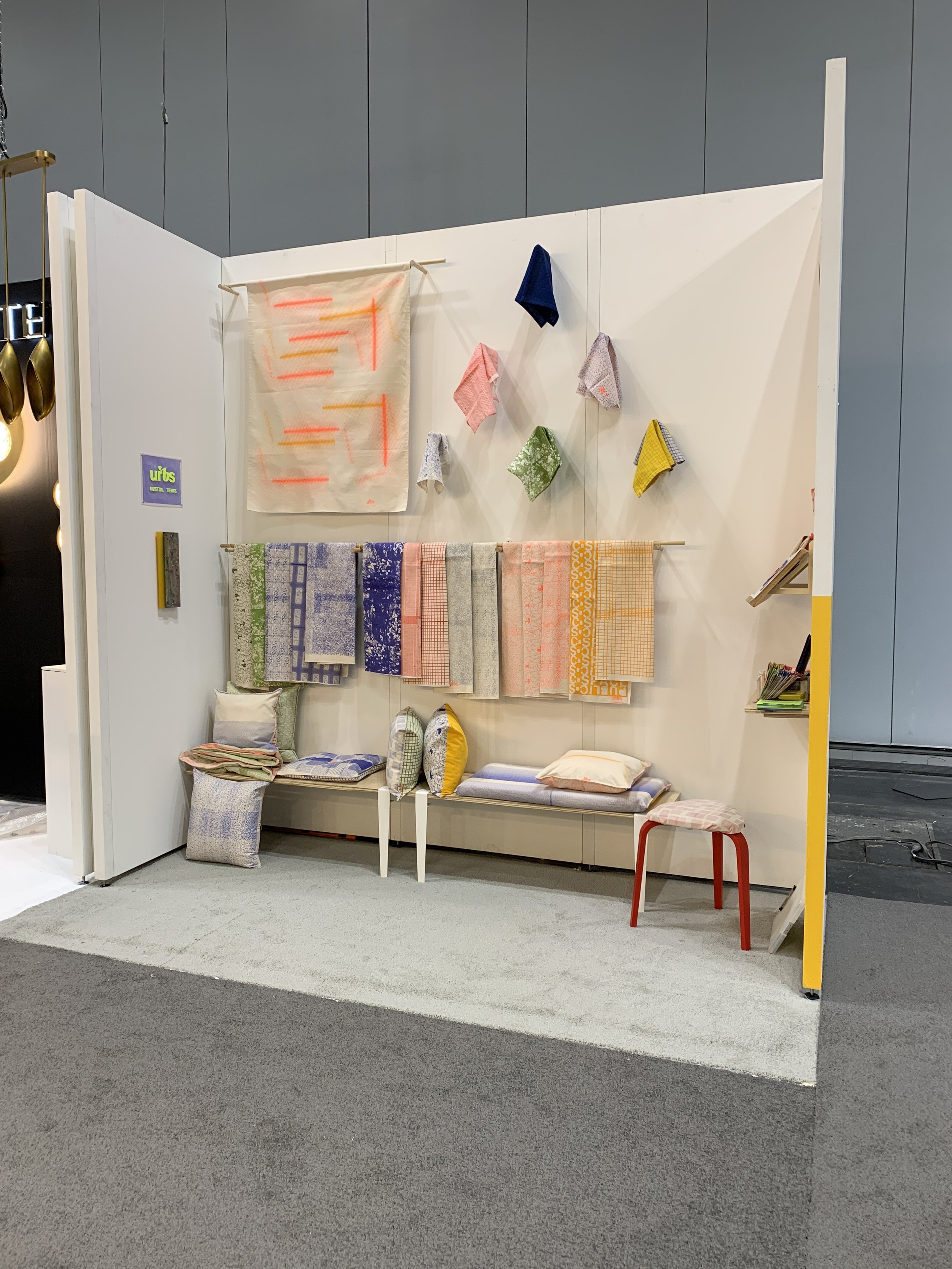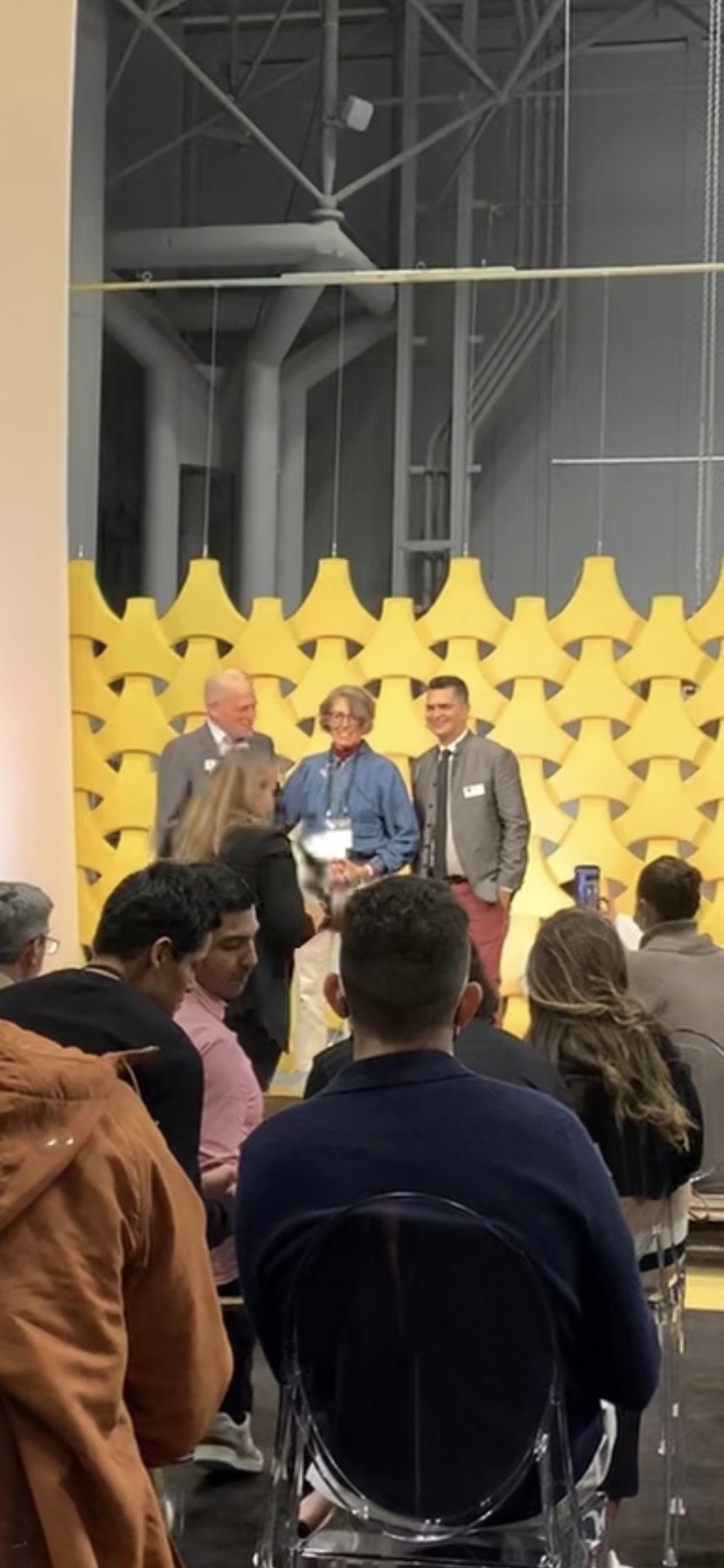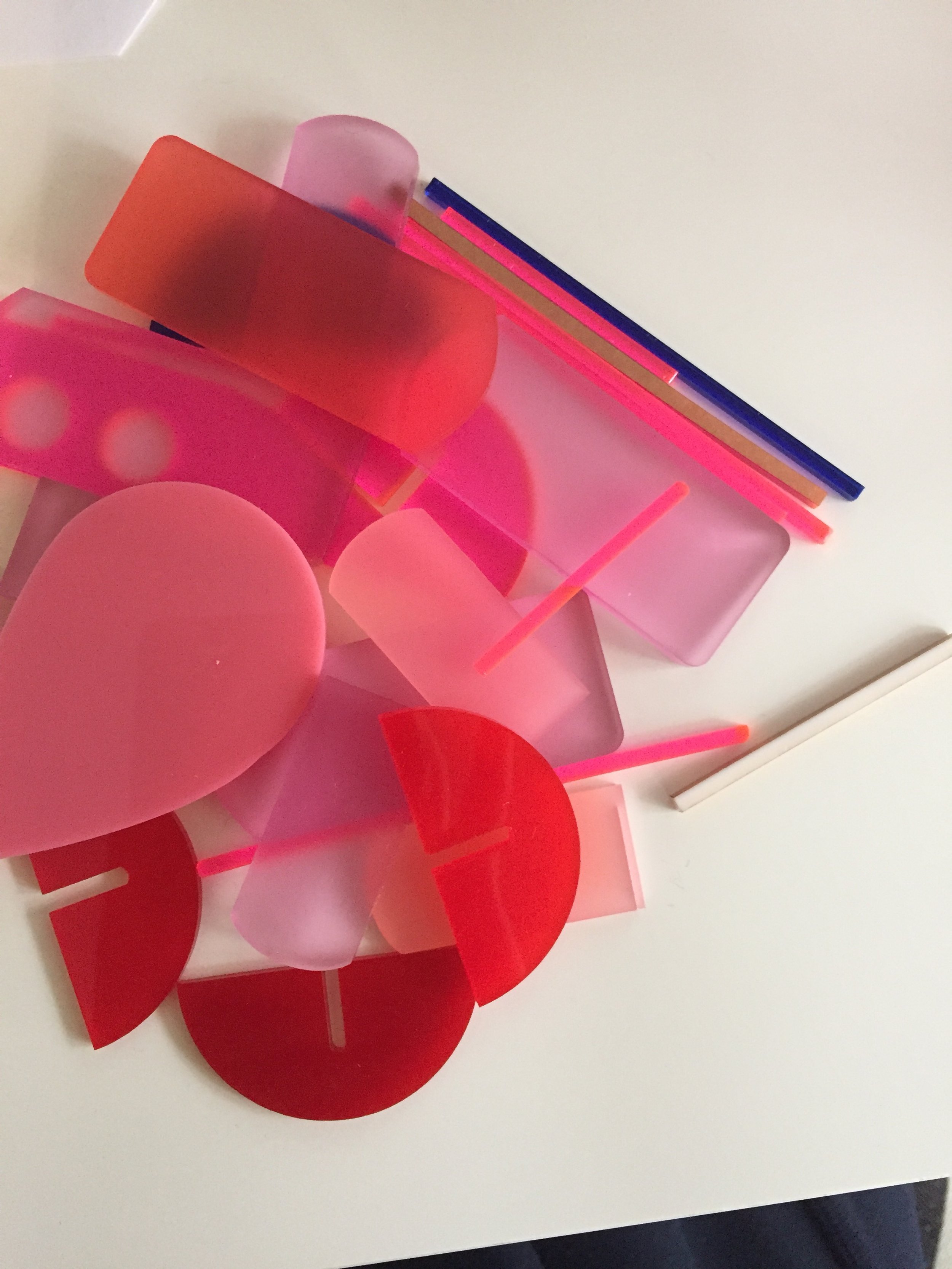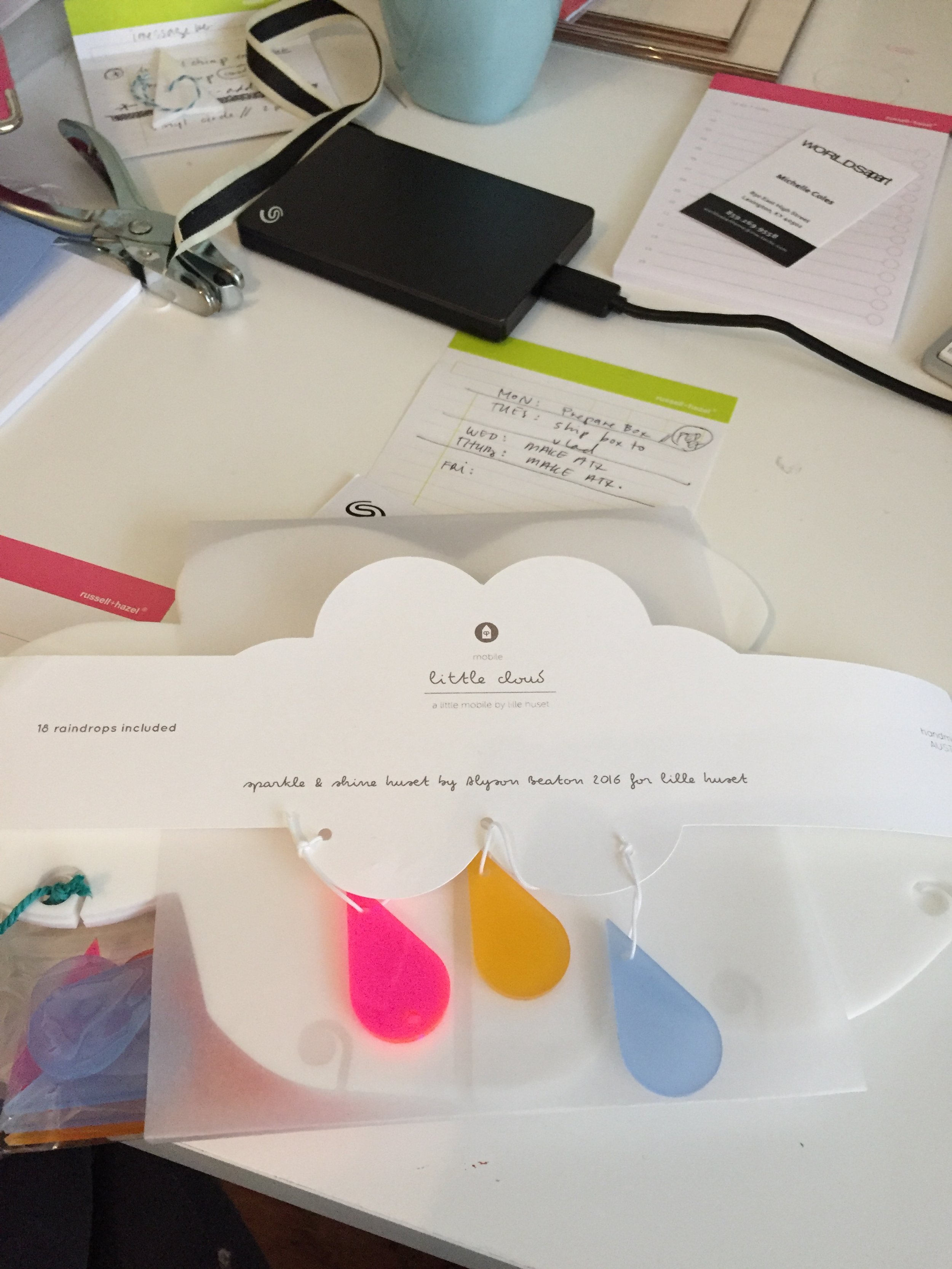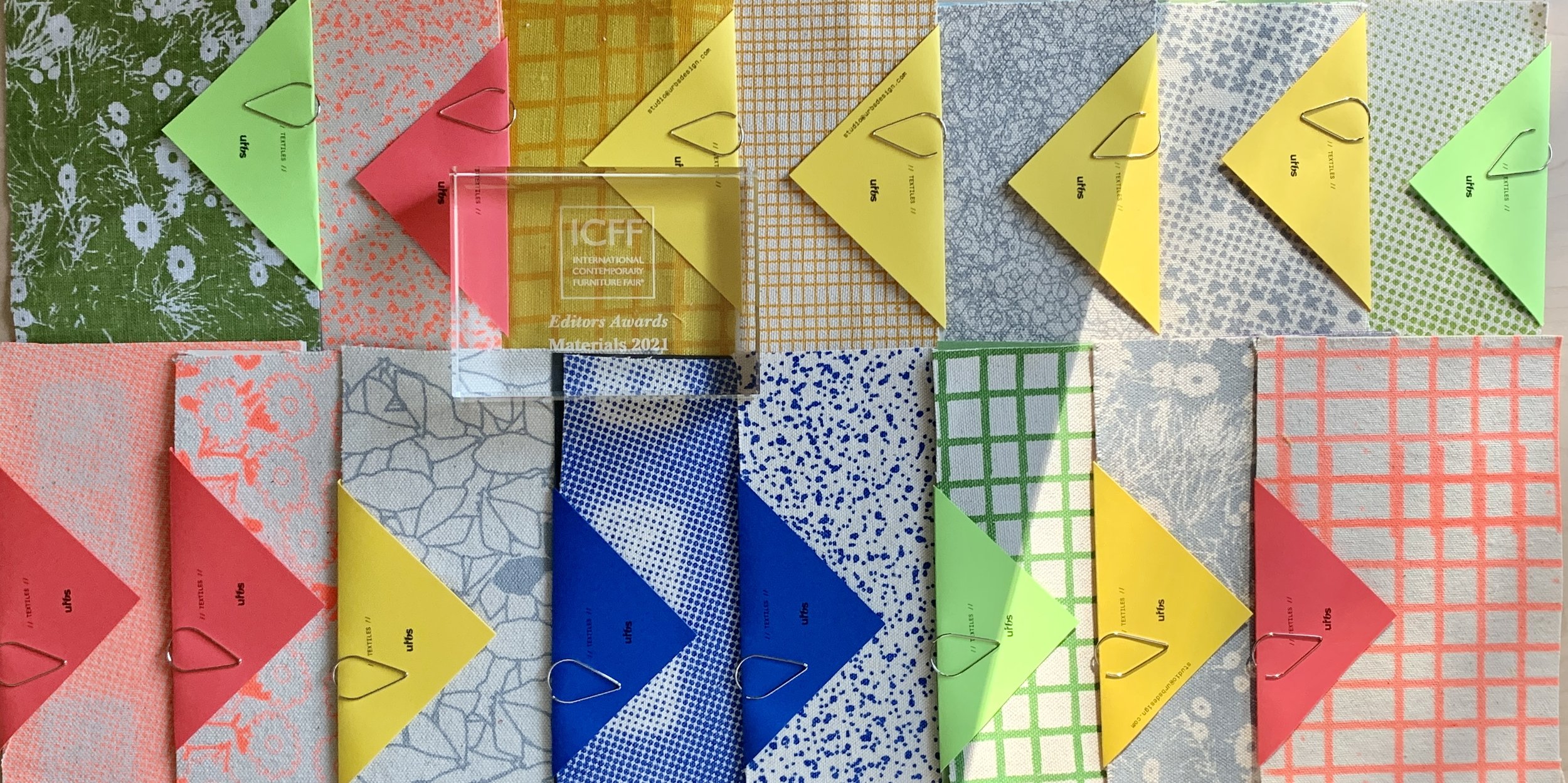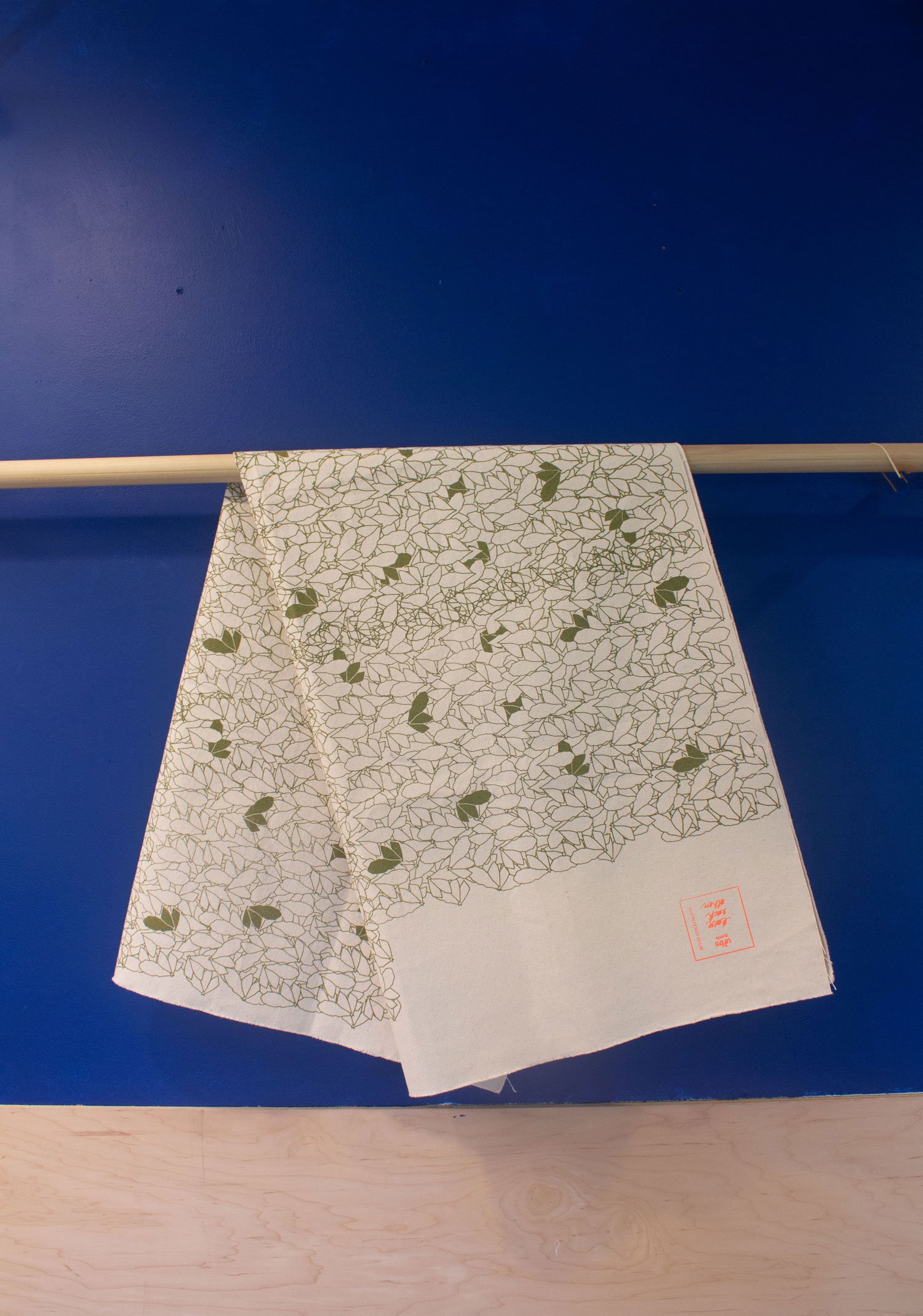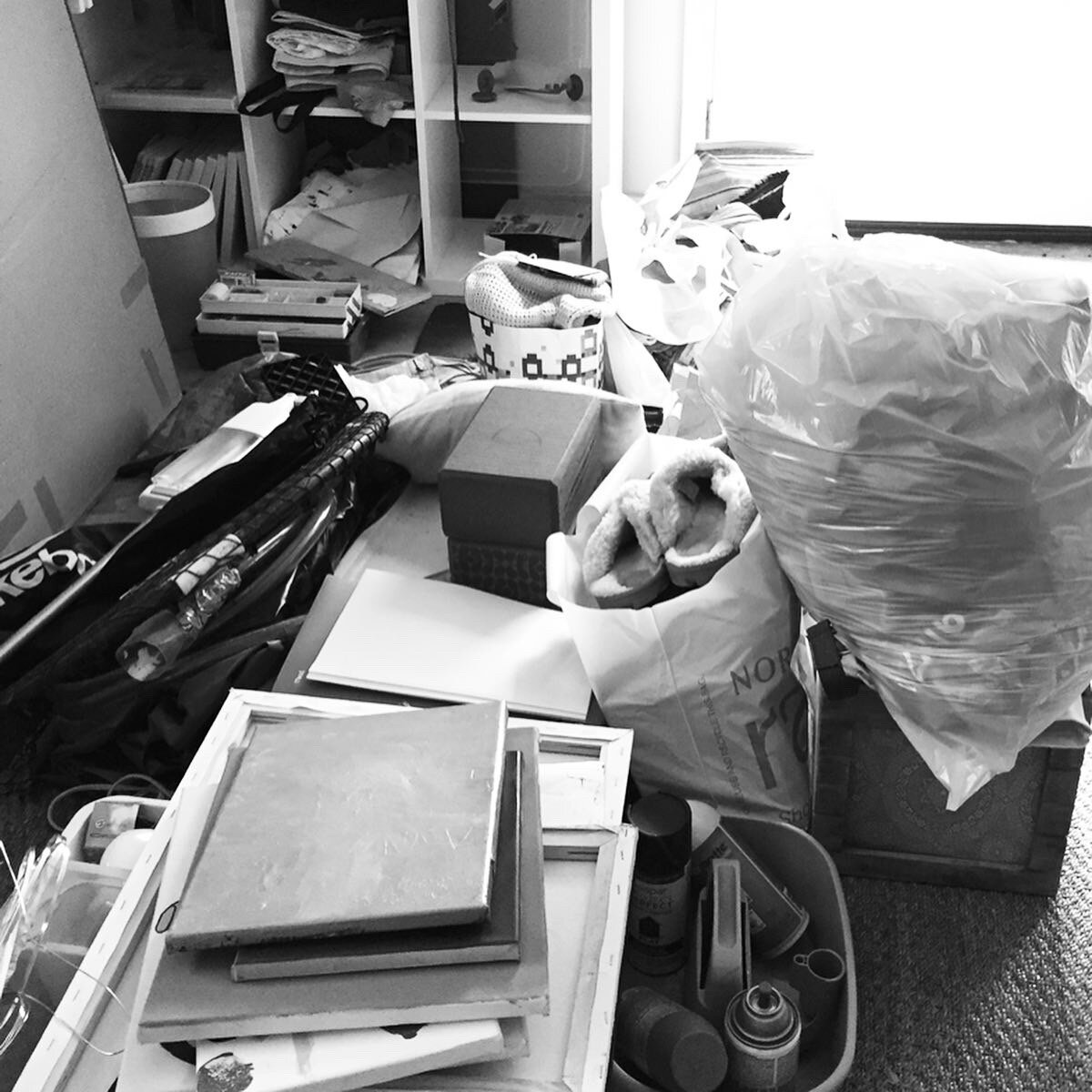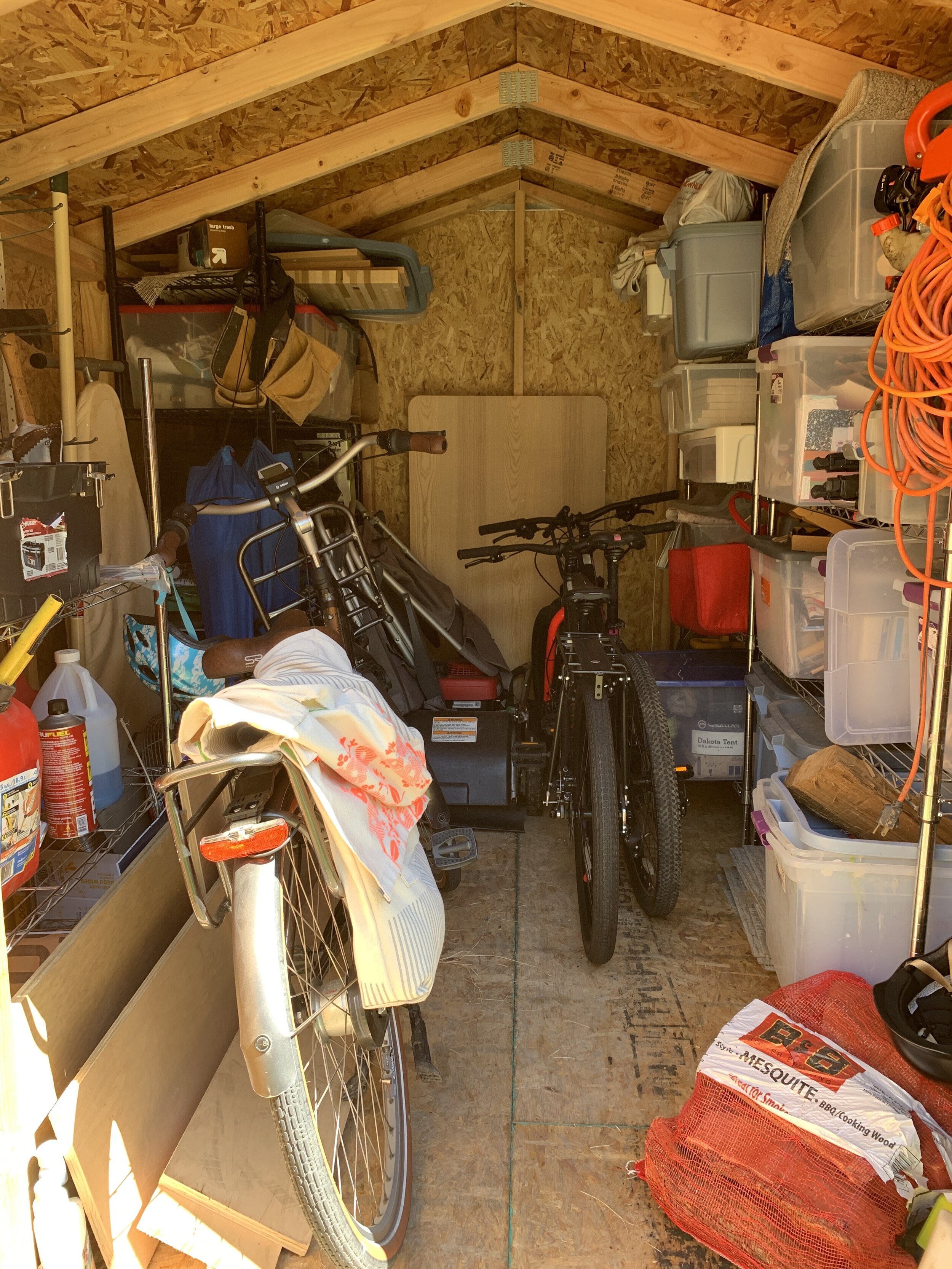Street View: Urban Hellscape
Street View: An Urban Hellscape: A visual discovery and celebration of urban grit told through textiles. By Alyson Beaton
Walking down the street on any given day, I pass an auto parts store covered with illustrations of every auto part on offer within the store including, but not limited to: nuts, bolts, widgets, tires, etc…. Each graphic is painted in a two tone color scheme: yellow and red. The graphics are half heartedly applied to a building that was once beautiful, a three flat greystone with a ground floor retail space that is now an off brownish gray color with a front door that adorns a rusted metal gate with at least seven locks. Around the corner I walk past a beautifully restored 2 flat building that has been converted into a single family residence. The house is for sale for 2 million dollars.
—-
I drive down the street on the way to my studio, driving past a cluster of old buildings, some with historic plaques dating back to 1910. The small storefronts have had many many lives but are now adorned with a cluster of street art claiming the space as an urban corner. Adjacent to the building is a huge dirt lot and three more randomly placed buildings, one claimed as a used car lot, a barber shop that looks only partly in business, and a pawn shop, and on the other side a 1990’s strip mall with a collection of shops like the Dollar Tree and Popeyes Chicken. Across the street, construction fencing is surrounding not one but two multi acre sites with six cranes in the air. There is no usable sidewalk in sight but people are still walking down the street, confused.
—-
I am walking down the street, I have just left a brand new complex that has been recently rebranded. It appears to be an old factory of sorts in a seemingly “good” location, right on the water, perhaps for new up and coming industries. I see loads of vacant space next door just begging to be used, most likely reserved for a tech start up, but every inch of the space I am in is occupied as we weave up stairs and down small hallways. As I leave this revitalization dream, I pass parking lots full of cars that don’t appear to have been put there intentionally and am seeking a path to the nearest subway train to go back into the city. I walk past buildings with businesses I don’t recognize, check cashing places and beauty salons, all with some sort of handmade curtain that would resemble a bed sheet, and vinyl signage adhered to the glass.
—-
I walk down a street that I have been on many times before, but this time the street is completely different. The construction fencing and cranes that had been here for years are all gone and in their place parks a new museum, high end shops and urban trail. This space is now a playground for the uber rich and consumers seeking an up scale experience as an architectural wonderland with an escher-like spectacle that is blocked from public consumption due to the high rate of teenage suicides that have taken place there, apparently caused by the sculpture itself.
—-
The cities we live in are in constant change but all share the same DNA and life cycles, development and redevelopment. Gentrification, walkability, independent businesses are all things that define our urban cores along with the homeless under blankets behind any crevice out of sight. Our cities define our times, they are the places that unite us in crisis, where we march in the streets in mass messaging, they are the places where you can’t choose your neighbors, they are the places that allow us to express ourselves freely and snag whatever we want if we want it badly enough.
The Street View Collection: Urban Hellscape is evidence of those ephemeral moments that define our cities, the median meadow that appears only once a year transforming a previous civil engineering design element for traffic flow into a beautiful scene. The glimmer of light that reflects off the glassy buildings when the sun is just right, the moment when the city lights up as day turns into night, the odd spray painted messages that appear on the ground mysteriously a code that only the workers can read, and the street art that reclaims a vacant structure often times just for a short moment before a new tag appears.
Collection Prints: Urban Code, Hellscape, Median Meadow, Glimmer, City Glow, Grit, Open, Scribbles.
Urban Design: A Textile Collection
Urban– Design: A textile collection
Awarded the ICFF Editors Award for Materials and Textiles 2021
When I lived in Chicago years ago, I distinctly remember people saying that everyone in Chicago has an architectural vocabulary, even the cab drivers can tell you about Louis Sullivan and this city that was planned by Daniel Burnham. The idea that a city can be designed for people, all people, to live in and flourish. Fast forward to the 20-teens, a time and place where small towns are booming, and as they grow the city planning has changed. In this new city the spaces that, in Burnham’s plan, are public, equitably distributed and cared for by the city, are now falling under private stewardship allowing these half public half private spaces to limit its use to those who are allowed. The place where I live, Austin, Texas is one of these cities.
As I collected inspiration for the Urban– Design collection that I launched at ICFF in November, I dug deeply into the archive of conversations I have had with neighbors and things that are causing people to talk. I am in a city that is transforming before my eyes, with old and new ideas colliding, creating a conversation among even the most average person that turns toward words like gentrification, land codes, urban trails and a new transit system in a place defined by roads and highways. All of this change is leading to high housing prices, and mass waves of newcomers from big cities looking for a slower life. This rapid urbanization affects everyone who is here, as regular citizens are constantly asked to come together in the form of neighborhood associations, normally in place to make decisions about lawn care and where a new stop sign needs to be, are invited to decide if a developer who has dollar signs in his eyes should be granted a “variance” to build a thirteen story building right next to a single story ranch house. Everyone is invited, and everyone is affected by the outcome.
I set out on this mission of design, as an observer of our culture, the subject that surfaced, urbanization. The history of this movement dates back to the destruction of our first city, NYC by Levittown and the first interstate highway designed to cut through the ghettoized city designed to get people of one race out of it as quickly as possible. The cities and how they evolve are the philosophy books of our time. The things that shaped our cities of the past are that of a social order, our cities are the places where people are, and where we will continue to be as cities everywhere are growing by leaps and bounds, constantly creating a conversation and patchwork of ideas about how these places will evolve and what is the correct way to do it.
As a designer, I find myself constantly making artifacts that are visual diaries and evidence of these places. Using screen printing and fabric as my medium, in the most appropriate form to express my subject, referencing that of street artists and pop artists, getting the work out as quickly as possible, applying in unassuming ways to surfaces and objects that no one would imagine could hold hidden messages of a new movement: the revitalization of the city.
The Urban– Design collection is that of a walk down the street, illustrated moments, like the overgrown foliage that no one maintains, creating a wall only in the summer months where it previously was not. The collection is based on the ideals and implementation of urban design that has aged, changed, been redeveloped and will become something that ultimately the people own through living in a place in time.
This collection was previously un-named, but has now taken the form of the following prints:
Break the Grid, Patina, Community Greens, Public Spaces, Tributary, Encounter, Wander.
ICFF November Edition
Back in November, we packed up our stuff and headed to NYC to launch our brand at the International Contemporary Furniture Fair. The fair normally runs in May, but because of the pandemic, had a special November edition. Honestly, after almost two years of being remote and trying to start a company without any human contact, it was hugely anticipated. I worked on the collection everyday day, editing and sorting and squinting and changing and printing again.
Images above by Ethan Thuringer
The fair was on the small side due to the pandemic, but it was great to see so many people still trying to function during this ongoing situation. We were so pleased and honored to walk away with the textiles award!
Urban Essentials
As we moved our lives from a house with loads of storage, masked as a two car garage that no car ever had the luxury of inhabiting, we purged the excess, linens in multiple sizes that would grace the table only on special occasions, to remain in a drawer the other 364 days. We plowed through the ephemera of our lives with two kids that were getting older and didn’t really need the things we collected for their growing use, piles of blankets in all sizes and shapes designed to fit their body for a very short time, trendy throw pillows that are no longer visually desired, and piles of freebie bags that were handed out at every event just to be thrown in a bin, never used twice. It took us more than a month to shed the past, leaving us with a modest pile of boxes that had everything we needed as we headed to our small city home.
Ink, Paper, Fabric, Color + Print
As a designer I am constantly intrigued by the possibilities of color in spaces. In our studio, my process plays with the overlaps of colors and textures to create statements in spaces that compliment that of the world around us. When someone enters a space for the first time, the impression is made. There are visual negotiations happening within the person, visual cues and overall feelings about the experience. In my textile practice, I have gravitated toward flat natural fabrics that lend themselves to screen printing, holding the inks, soft to the hand and are environmentally responsible. As a visual person, I am in constant conversation about how to transform the printed fabrics into products for spaces. The fabrics themselves being as commonplace as a painters canvas but when graphics are applied they come to life in a completely different way.
Le Corbusier Ronchamp Catherdral // photo taken 1995
I began my career fascinated with paper and printing. I worked for an architecture firm in Dallas creating a role for myself that was graphic in nature. I never saw the graphics as the outcome, but rather the juxtaposition of paper and effects, I immediately was drawn to embossing, watching the light work with the paper and rubbing my fingers on the page to feel the words. I created pockets and folders, all with printing techniques that challenged the medium and creating printed pieces that would engage a viewer. I saw my book design as very much a kin to architectural spaces. In architecture school we worked with paper and wood to create light modulating models along with fine pens and inks on the finest papers and boards. After creating the models, we would cast lights onto them watching as the shadows danced through the tiny room. We learned to engage with line of varying widths and styles to communicate things in drawings that would denote how a building was to be built. I fell in love with these lines, watching my fine tipped micron pens create the patterns of the striation of the earth in section focusing on the tiny details.
Urban Textiles An Interview By Meghan Dwyer of ICFF
MD: Tell me about your company! When were you founded and what do you do?
AB: Urbs studio officially launched in 2019 as a project based studio. My husband Matt and I joined forces to work on self-directed projects that tell the story of urban life. The goal of the studio being simple, to create works that had no client boundaries and would allow us to play. After returning to Texas in 2015 I had just completed a children’s textile collection with Windham fabrics that was based on my children’s product line, Lille Huset. I loved working on the designs but I also wanted to start to think about textiles for the home.
I was so thrilled to have won the editors choice award for my textiles. Meghan Dwyer of ICFF did an interview with me and gave a synopsis on their site. You can read that here
Below is the complete interview…
MD: Tell me about your company! When were you founded and what do you do?
AB: Urbs studio officially launched in 2019 as a project based studio. My husband Matt and I joined forces to work on self-directed projects that tell the story of urban life. The goal of the studio being simple, to create works that had no client boundaries and would allow us to play. After returning to Texas in 2015 I had just completed a children’s textile collection with Windham fabrics that was based on my children’s product line, Lille Huset. I loved working on the designs but I also wanted to start to think about textiles for the home. Having a background in printmaking and also feeling the need to make with my own hands again, I rented a studio space in east Austin and joined a printmaking co-op that allowed me to start printing. I immediately fell in love with printing on fabric, dusted off my sewing machine and also started sewing them into different products.
It was around the time when Matt and I were working on our home renovation in central Austin that I wanted to create textiles that made our home as unique as the place we were living. Textiles have the power to say something about the people and the place they were created, and I wanted what I made to connect with the people using them in a special way. I still remember the floral patterns on my grandmothers aprons growing up and they have a special place in my memory. There are so many beautiful textiles on the market but I wanted to create some that really spoke to urban life, which to me is unexpected and constantly changing. When I began, I was designing and printing for table top, but I knew that I also wanted to push myself into a larger scale pieces because textiles can really transform a space. As I began working at the larger scale, I really loved how the designs came alive. I began printing on natural cotton canvas which is super durable and a great fabric for the process I use. As a business I wanted to establish our textiles as bespoke and work with designers in this way. I also wanted to introduce fabrics that are circular as well as inks that are eco friendly.
MD: Where did you grow up? When was the moment you knew you wanted to be a designer?
AB: I grew up moving cities every 5 years or so. I arrived in Texas when I was 10 years old and lived in border towns to Mexico. Because we relocated so often, I tended to create my own world wherever we lived, almost like my own retreat. My childhood was spent largely making things, sewing and crafting projects for school. I knew I was a designer when I enrolled in college and chose to major in environmental design (architecture). The projects were so exciting and I was learning to see the world for the first time. The rational and creative were aligning and it was amazing. Matt and I met in our architecture studio in undergrad. We had both landed in this major not knowing anything about design. Growing up in Texas has very much informed the work that we do, whether it be textiles or other projects. I spent most of my grad school time in Chicago unpacking the stark difference between city life and sprawling suburban life. Matt and I clearly fell in love with the urban, and watching Austin begin to transform is extremely exciting. We are watching this place we have known for decades transform before our eyes and we get to be a part of that.
MD: What was the inspiration for Urbs?
AB: Urbs is latin for City; we felt this name was the strongest identifier for what we do. Urbs is an open ended, and somewhat free form, way for us to work on or collaborate on projects that excite us about urban spaces.
MD: Can you explain the different branches of the company?
I think of what we do as projects, mainly because we are so new and small. When we started the studio we didn’t know what direction it would go. We are truly very interdisciplinary and are constantly seeking answers to questions about how design is a part of the world in a very real way. Matt works full time in an architecture office doing affordable housing projects and I work in the studio on largely self directed works but am focusing on the textiles/design.
MD: Tell me about the textiles. Do you design all the patterns? Where and by who are they manufactured?
AB: After moving back to Texas, I joined a printmaking co-op in the city, where I began experimenting with fabric printing and creating designs. At the time I taught university design classes on the side, but wanted to keep developing screen printed textiles. I design all of the patterns and they are all inspired by the places we have lived or visited. Our collection is a very personal body of work that has been growing over the past six years. It wasn’t until the pandemic that I knew it was time for me to quit my teaching job and focus on the one thing that truly made me happy, textile design. I found that the printmaking part of my design process was almost like sketching. All of my work is developed on the press after working on base designs in the computer. All of my designs start with a hand sketch which I bring into the computer and manipulate for hours, and sometimes days and weeks using illustrator. Sometimes I have a word in mind that I am creating a pattern for, but other times it is political and other times just something I find beautiful.
When I am creating the patterns in the computer, I work only in black since this is how I will print the transparencies for screen printing. It isn’t until I am done making my screens and putting ink to press that I know if the print is visually working. I spend a lot of time experimenting with colors of fabrics and inks. I also mix all of the inks myself, so I obsess over colors and how to get the right shade based on the fabrics I am printing on. I have lots of prints that do not work, when this happens I wash up the screen and start again. Most of what I do is editing and trying to step outside of myself to critique the outcomes. As I develop prints and colors, I always want them to work together. At the end of every printing session, I stack my prints and snap a photo. This is my favorite part of printing, seeing them as an outcome that was 100% part of the process of work from that day. In my studio I hang the work up so I can be in constant back and forth about what to do next. After a printing session I introduce the new pieces to the existing. As you can imagine my space is incredibly messy but also insanely colorful! I love showing people the work in person because it really comes to life this way, you need to touch it and get lost in all the possibilities. I want my studio to inspire other peoples creativity and make them want to dive in and find the right prints for them.
MD: Do you do custom work?
AB: Yes, I do custom work for clients but it usually starts with some of the work I have already produced. I have dozens of original prints that I have developed over the years, and many in different scales or colors. Creating a brand new pattern or collection takes a lot of time and consideration of final application, but it is certainly something I do enjoy.
MD: Do you produce other furniture or products?
I design soft goods for table top, bags and recently designed a rug. I have a bit of an obsession with the bag specifically for urban use. When you walk out of your house your bag is your main accessory that has to be so functional and versatile. I also desperately need to see my fabric in application, so sewing samples is a critical part of my process. When I was working on this collection, I really wanted a piece of furniture to put the textiles on, but like any good design, you can’t rush it, so I am still searching for the right piece. Furniture for me is particularly exciting, I hope that in the near future I can collaborate with furniture designers.
MD: What patterns did you show at ICFF?
The collection I showed at ICFF is my most edited body of work. It included fifteen designs in six color ways, all named after aspects of living in the city. The names of the prints are based on different aspects of urban life; Patina, Encounter, Resilient, Grit, Open.. Open was one of my most recent prints, it is represented in a a way that makes it illegible from close up, but is also based on a signal of urban life, the “open”sign. It was during the pandemic that I realized the value of that ubiquitous symbol for representing a functioning place, our businesses are so important in our cities. As the world opened back up it gave me great comfort in knowing that people were beginning to get back to life and knowing that things are functioning, but the use of the small dots to create the sign also makes it ephemeral. All of the prints represent the evidence of human existence in a place in time.
MD: Where can people find your textiles?
Right now, since the collection is brand new, you can find them through me at urbsdesign.com. I want to keep the collection hand printed and bespoke, so designers can find that special piece for their unique space. I would also love to work larger and collaborate with manufacturers on bringing aspects of the collection or new designs to a larger audience.
MD: What was your favorite part of being at ICFF?
This year specifically was incredibly emotional. I created this line over the pandemic, and it had not seen the light of day, and I was also eager to get feedback. I had no idea how it would be received. I decided to take this incredible leap during a year when it was almost impossible to start a business. ICFF for me was the launch of my brand. All of that being said it was such an amazing experience, and one I did not know we would have the opportunity to do given the ongoing pandemic. My favorite part of participating is the morning of the first day of the show when all of the booths are assembled and everything looks so amazing, that moment makes me feel like I am part of something really special. I love design and events like ICFF bring designers together from all over to connect and share their work, which makes all of us better designers.
A Pandemic Collection
When the pandemic began, I started writing. I wanted to document what I was feeling, the confusion, disruption, and forced change in our lives. I sat here hoping that things would go “back to normal,” as the year wore on, I worked on my textiles, taught my classes on zoom, with my kids at home doing school, and my husband across from me, also on zoom. Although I have been making textiles and prints for coming up on six years, I was making my work previously, to a standard, or as we say in the classroom, obeying the “rules.”
When the pandemic began, I started writing. I wanted to document what I was feeling, the confusion, disruption, and forced change in our lives. I sat here hoping that things would go “back to normal,” as the year wore on, I worked on my textiles, taught my classes on zoom, with my kids at home doing school, and my husband across from me, also on zoom. Although I have been making textiles and prints for coming up on six years, I was making my work previously, to a standard, or as we say in the classroom, obeying the “rules.” I was printing and sewing, perhaps to just stay sane and to have something in my life that felt normal. It was in that time that I started to realize how not normal everything is and perhaps how it never was. The pandemic allowed me, for the first time, perhaps in my life, to take notice of things I hadn’t before. I was able to truly observe the world in a way that was void of noise. Our lives literally stopped. Creatively, allowing me to really find where I am as a maker. I began to meditate and look inside myself like I never had before. I am allowing myself a freedom from expectations, I am closing my eyes, and making the work that I see in my mind. I came through all of this with only one artist statement and a new way of making.
My work is a reflection of life, or how I view it. It is not about meeting an expectation of what life has set out for me, it’s about overlapping moments, unexpected encounters, elegant simplicity, and sometimes bold statements. My work is a reflection of the complexity of the relationship between humans and nature within the built environment. Our world pretends to have systems, systems that promise things, but as I live, I come to realize that these systems are so complicated and dense. Everyone fighting for light, for an issue, for others, this great tension creating moments of beauty when justice has been found. My work and my making is an expression of that overlap, the growth, but also the realization that none of us knows how we will evolve.
My work is created in a way that can not be replicated by a machine. The work I make has to be hand produced, and in the hand work, the final composition takes shape. The overlapping of forms, the mixing of colors, and the moment in the making that brings it to life. I have created my own system, but it is one that is defined by the unexpected, change and whim.
The Vision of the City
I’ve been spending a lot of time on Nextdoor recently, obsessively reading the endless stream of posts about the impending doom that the Land Development Code rewrite will be delivering to the City if it passes. There are foreboding tales of the wanton destruction of entire neighborhoods and ways of life, warnings about massive flooding, wholesale removal of the tree canopy, and the total displacement of existing residents to make way for canyons of apartment buildings which will block the sky and choke the streets with gridlock.
Imagine if there were more bikes and pedestrians than cars, walking and biking in the shade to wherever they needed to go? (Photo: City of Austin website)
I’ve been spending a lot of time on Nextdoor recently, obsessively reading the endless stream of posts about the impending doom that the Land Development Code rewrite will be delivering to the City if it passes. There are foreboding tales of the wanton destruction of entire neighborhoods and ways of life, warnings about massive flooding, wholesale removal of the tree canopy, and the total displacement of existing residents to make way for canyons of apartment buildings which will block the sky and choke the streets with gridlock.
I keep reading these posts because I am trying to understand the hopes and fears of Austin residents. Many people who have lived in Central Austin for a long time have gotten used to a certain way of life: a single-family home on a large lot, an easy drive to all of the amenities that the City has to offer, free and ample parking, and a relaxed, small-town vibe that Austin is known and loved for. It’s hard to blame these people for fearing the very real changes that are happening in the City. They are absolutely correct that the future of Austin will not look or feel much like the Austin of the past. Like all cities in history that matter, change is and will be a constant feature of the built environment. And Austin is a City now, make no mistake. The population of the Austin area is now around two million, with half of those in the City limits. Austin is now the 11th largest city in the United States. It’s definitely not close to being the densest, though. A quick (and admittedly amateur) study that I performed using GIS data indicated that of those million people, only around 200,000, or 20%, of Austin residents live in the central core, which I loosely define as being bound by Anderson Lane and 183 on the north, I-35 on the east, Ben White on the south, and Mopac on the west. This is the area where any part of central Austin can be reached without using or crossing a highway, and in my opinion has the best chance of someday becoming a truly compact and connected City that can be traversed easily by walking, biking, or transit, in addition to (or instead of) private cars. This area is roughly the same size as Amsterdam, which holds over three times the amount of people, and somehow does it with little to no traffic gridlock and a humane, pedestrian-oriented way of life.
We have all witnessed the rapid push of capital and development on the east side, where the existing residents have historically had the least power and wealth. This will likely continue, because of basic laws of economics and capitalism that we live under here. This growth is exacerbated by the historic resistance to development by the residents that live west of I-35, and especially west of Lamar Boulevard. These people have much more clout, wealth, and influence, and seem to be the loudest voices against the LDC rewrite at this point, at least from my limited viewpoint perusing the Nextdoor feed and from witnessing the proliferation of anti-“Code Next” signs popping up in front yards. I don’t think they are bad people; they are protecting what they see as their self-interest and way of life, which is completely natural. What I think is lacking is a Vision of the City that all Austinites can get behind. The Imagine Austin plan issued in 2012 was an honest attempt at creating that vision, and the picture it painted certainly helped convince us to move back to Texas, after all but giving up on it many years ago. But maybe it didn’t go far enough, or maybe it was presented in a way that gets architects and urbanists like me excited, but didn’t do much for the average person living in Brentwood or Hyde Park.
It’s a real dilemma; the idea of a dense, walkable City of interconnected neighborhoods in a wonderful place like Austin sounds like a slice of heaven to me. Austin is livable outside for at least 10 months a year in the shade, which is more than we can say for New York, Chicago, Seattle, or Toronto. Imagine a neighborhood of houses, duplexes, triplexes, small apartment buildings, small shops, restaurants, offices, schools, libraries, markets, parks, and plazas, all under a canopy of beautiful shady live oaks, connected by shared-use paths and streetcars. Taco trucks and outdoor cafes on every corner. Imagine North Lamar as a beautiful tree-lined boulevard with a street wall of wide sidewalks, shops, restaurants, apartments, and a light rail line, instead of the dangerous, heat-blasted, utility-pole infested hellscape it is today. What if the people of Austin spent their daily routines meeting each other and being neighbors in active streets and parks, instead of stuck inside their cars and houses? What if Central Austin was not designed as a place to drive through as fast as possible, but as a place to be lived in? What if there were enough homes for all kinds of people, rich or poor, single or family-oriented? What if everyone in Central Austin could procure all the necessities of life within a 10-minute walk of their homes, under shade? How can this vision take root and be seen as a desirable future for all of the residents of Austin? This is a real question; we’re not sure we have the answers. We started URBS to try to figure that out.
Storage of The Stuff We Love
We all have stuff, how much stuff depends on who you are, and how much room your home has to accumulate more! As collectors of things, we tend to fill spaces with stuff, to surround ourselves with items that give us meaning and define our home as a place we love and want to be.
bookshelves to the right before we added a top and knobs!
Entryway
We all have stuff, how much stuff depends on who you are, and how much room your home has to accumulate more! As collectors of things, we tend to fill spaces with stuff, to surround ourselves with items that give us meaning and define our home as a place we love and want to be. Regardless of how you accumulate your most cherished belongings, each of us needs the space to store them in our homes. As I mentioned in my last post, we have downsized and along with that came the gross reality that we had to confront all of our stuff, picking and choosing which items had the most meaning and more importantly, how we would not continue to collect things that had little or no value to us. When we began designing our home we looked at the most important things and designed a place for all of them, including our very large dog. We also had to, and still are, trying to figure out how to manage our lives, so stuff doesn’t pile up again, ultimately eliminating extra junk.
We had to take note of the places where things begin to pile up, and what we noticed during our purge, was how much stuff we had in our closets and bathrooms. I know I am not alone on this, but as you look at how houses have evolved over the decades, our houses have more, and bigger bathrooms and loads of closets. We have an understanding that we need a bathroom in every bedroom of the home, this, to me, is completely unnecessary. We are also storage obsessed! I have had an en suite bathroom and to be honest, I don’t prefer it, and I’ll tell you why. At this point in my post, I’m fully aware that I am going to step on many toes, but I have to let you know, what I have observed and what I think, so keep reading at your own risk. When we cleaned out our bathrooms, do you know what we found? We found expired medicine, lotions half used (multiple) shaving creams, travel sized items not fully used up, random razors, toothbrushes, cleaning products that promised to keep our shower gleaming, that we never remembered to use until the mildew was beyond what they could do, exfoliators, old makeup, the list goes on and on. All of the things we cleaned out, were things that would continue to accumulate, because we simply didn’t know what was even in the cupboards. Our solution to ending the overflowing bathroom randomness was to keep, what we call, our “pharmacy”, in our pantry, this is simply a basket that we all use and it stores all of our essentials and even extras. When we run out of something in the bathroom we go to the “pharmacy” and get another. This keeps us from not knowing what is in the cupboards. Matt also keeps an amazon list for re-orders when this basket runs low. We designed our bathrooms with minimal storage, and limit that storage to the things you need in a bathroom, extra toilet paper, towels, etc... Products aside, I also believe that you should always share your bathroom. Why have we come to a place in time where this is an honored space to lavish ourselves? I see a bathroom as a space to shower, use the toilet and get ready, the more minimal the better.
Next up, closets. I hate them. They are closed off rooms where we can endlessly pile stuff. There are weird back corners where you never know if something is lurking, and it’s where we put stuff we want to forget about. That being said, I am a fan of wardrobes or built in storage. In our bedroom we have a pass through closet and I designed it that way, more as a dressing room with our clothes than a closet. I believe that we should have to confront the things we possess. I have read lots of minimalism books on how to do your wardrobe, and I am not sure about limiting yourself to 4 pairs of pants and shirts, but I am into the idea of knowing what you own. I am in my 40’s and regardless of fashion, I have always purchased the same types of clothes. However I do this, I want to be mindful that I am not feeding a fast fashion machine, but also not just buying stuff that is on sale, but buying stuff I actually love. When I get a garment I love, I will wear it until it has holes in it and is pretty much done for. For our kids, we limited them to a wardrobe in their rooms, our daughter needed hanging space but our son didn’t, this limited space for accumulation. We also have a coat and linen closet at the top of the stairs. I used all IKEA kitchen system for all of our built ins. I have found over the years that their kitchens are great quality and made in the USA. I can’t speak for their closet systems, but they don’t look to me, like they can take a lot of wear. Our kids are not gentle with their things and these systems are amazing. The best part is that if you ever what an update or change out, you can just buy a new door.
In our kitchen, we have a walk in pantry, the only fully enclosed closet in the house. We did this because it is our only storage and we needed a full height place for brooms, dog food, our pharmacy items, and small . appliances. We also keep some tools and our good china in there. We love the IKEA pantry system for storing our food. Much like the bathrooms, food gets pushed to the back of the closet and forgotten about. The more space you have to store your food, the more food you will store! We have limited space for food storage and it works great for us. OK, we can’t go to Costco, but I think that place makes people buy things they don’t need and forces more storage in our homes.
Finally, our dining room holds the rest of our belongings. We designed in a full wall bookshelf and small . cabinets to store our linens, games, and photo albums. We wanted all of our things to be on display if they have meaning to us so we made sure to have room for everyday items. This space currently has become a repository for our everyday stuff, like mail and kids homework, but it works. I love hooks so we have those sprinkled throughout the house and they seem to do the job for seasonal items. We also have an entryway that catches all of our stuff, keeping it out of the rest of the house. I call it the dumping ground, on any given day it looks a mess, but we can tidy it at a moments notice.
Shift in Society
I am writing this post as we enter the worst climate disaster in human history paired with a shift in our financial structure as we have known it. We are, I hope, on the brink of a carbon neutral existence and I also know that will come with great discomfort to many of the financial systems we have in place. I am 44 years old and have grown up on the cusp of two generations, right at the edge of the shift.
I am writing this post as we enter the worst climate disaster in human history paired with a shift in our financial structure as we have known it. We are, I hope, on the brink of a carbon neutral existence and I also know that will come with great discomfort to many of the financial systems we have in place. I am 44 years old and have grown up on the cusp of two generations, right at the edge of the shift. When we were in college, we were the last to learn hand drafting and also were introduced to the computer. We had the internet for the first time as adults, email, and the futuristic “connected” global workplace. We graduated just after a recession and jobs were plentiful. When the last recession hit, we had jobs, but those jobs kept us stagnant in wages and upward mobility. I was among the first generation of liberated women to navigate murky gender biased waters, making far less than my male colleagues my entire career. I am highly educated and under employed, still paying off grad school loans. My husband and I put each other through graduate school, having two kids in a broken health care system, desperate for dependable jobs to provide basic healthcare needs for our family. With every job we’ve had there is a small pile of retirement money sprinkled across random financial investment companies. However, we don’t plan to retire and are building a home that can sustain us into the future and possibly our children.
As we sit on the brink of the next future, I feel the burden to be the first to accept this new reality, one with little or no retirement, one with no promise of a job, one with little financial investments. I know I am supposed to feel fear and dread for what this looks like, but what I feel is the need to understand that this shift has been coming for some time. We have pushed all systems to the brink and something has to give, we have to change. I am not fearful of not having stuff, I am not fearful of not being able to eat a hamburger whenever I want, I am not fearful of not having a car or the burdens that previous generations have left us with.
Our current infrastructure is one designed for dependence on oil, but I believe we can shed these constructs. I think we are creative enough to redefine and redesign our society and no, it won’t look like it does in the movies, piles of trash all around us living in some container seeking refuge from reality in a digital existence. I find all of the ways in which we have defined modern life to be full of people seeking escape, seeking a way to hide and constantly “transform” oneself. I think many of us feel this way because we have not been allowed to follow our own humanity. We have innate human needs and the deepest desire to have a greater purpose. I know that our human future depends on this shift, although a great one, a real shift that will change the way we live.
I want to read news that doesn’t shed this future scenario as doom and gloom but rather as the way we are going to live, and in many ways that is much better than the way we live now. I want the news to be forward looking and problem solving, perhaps helping us understand better how we can live better. How will we solve these problems, how will we paint a picture for the future that is not dependent on financial success as our parents did but one of success in life and what that looks like. I would like to see a future where we value each other and the talents that lie deep within us, encouraging and supporting the independent efforts of those around us who need that support. As designers, we know that housing is one of the biggest issues facing our cities and will impact the future generations. This crisis must be addressed so that we can build our cities as sustainable places with true socio-economic diversity and places we can all live in and add to. This future city will look much like past cities, as these places came out of human connection and interdependence. Our cities need to support us and be the places we all nurture and care for. Our future cities are sustainable, responsible, and resilient. They are places where we all know that everything we do has an effect on not only us but our eco-systems. We are responsible for each other.
The Great Purge
I am writing this article with more than a year of hind site. The reason I think that is important, is because after you do a great purge/downsizing/reevaluating stuff and actually start living I think you are ready to write about it. If I had written this when we were still getting rid of stuff I was too in the moment and frankly overwhelmed to actually be objective about it.
I am writing this article with more than a year of hind site. The reason I think that is important, is because after you do a great purge/downsizing/reevaluating stuff and actually start living I think you are ready to write about it. If I had written this when we were still getting rid of stuff I was too in the moment and frankly overwhelmed to actually be objective about it. We made the decision about a year ago to move from a large-ish house (2100 s.f. plus 2 car garage) in the suburbs (having moved from living in the city in Chicago, a house about the same size with a full basement and garage) into a 1,700 sf house we were designing for ourselves; our family of four with various pets (this is kind of important because if your pets are as important to you as ours are to our family, you actually have to design them into the plan). This house does not have a garage or basement or even any real attic. We did however give ourselves a small storage shed (8x10) in the backyard for our bikes, tools, and we each got 1 tub of stuff to keep. That being said we embarked on what we called “The Great Purge.”
I am writing this to help you get through your own purge, and I will say that if you do it correctly, you need to be changing your living space otherwise you are just going to fill it all back up again. We started our project thinking it would take one good weekend and we’d be done. Well after a lifetime of hobbies, random furniture that we swapped out as the kids grew but hung onto, toys, clothes, dishes we didn’t need, appliances that were mostly broken, random bowls and containers with missing lids, too many cupcake pans, home office stuff, random cables, outdated phones and hard drives, baby clothes (my kids are 15 and 12) the list goes on and on, so hopefully you see where I’m going with this. If your life of stuff is even comparable to mine, this is a long process. All told, this took us about 9 months.
The first weekend was the hardest for sure. We started with our bins of stuff from the attic that we had moved from house to house since college (15 years ago). We found, much to our surprise piles of duplicate photos that we had printed with the roll and never discarded, high school notebooks, text books, photos that made it into photo albums and some that remained in their original paper sleeve from Walgreens. We had no idea what to do with it all. We closed our eyes, apologized to the planet and threw them away. Sadly, we figured either we do it now, or our kids will have to do it when we die, and ultimately we just didn’t have room in our new space. At that moment we adopted a new mantra, If it wasn’t something we could display and access on a daily basis, it had to go. We reserved a bin for each of us and kept things that held special meaning to us, the kinds of things that when our kids sort through them someday, it will remind them of us and our lives.
I know you are thinking, wow, what a harsh way to think about life, but in reality we had not looked at those things for decades and frankly never would. We threw away things that could not be donated or recycled. We made the trip to the Austin Adaptive reuse about 4 or 5 times and just kept creating piles of stuff that needed to head to a place for responsible discarding. In the process I also discovered that you can recycle old shoes and clothes that are just in need of a new life at drop off locations around the city. In Austin, you can find them almost everywhere, but I chose one that was in the parking lot of another errand place so I wouldn’t forget. Over time the process got easier for me and my husband although, sadly it did not ever become less of a chore until it was actually done. The purge consumed many, many, many weekends leading up to the move. The kids on the other hand had a really hard time with the sentimental nature of their things. I have to admit, I wanted to approach the issue gently because I feared that if I was too stern or harsh about it, they would end up becoming hoarders because their mean mom made them throw out their favorite stuffed animals and trinkets their best friends gave them as children.
Matt and I desperately wanted our kids to see the value of this exercise and embrace the new lifestyle alongside us. Since we gave ourselves a long time to purge, we introduced the idea of what stuff means. I wrote on our chalkboard in the house the basic rules for getting rid of things: Do you LOVE it? Keep it! Does it have special meaning? Keep it! Do you use it everyday? Keep it! Do you use it every week? …Have you not used it in a year? Is it broken? Is it random and NOT special? THEN IT HAS TO GO. We talked to them about random things we bring into the house that just end up in the trash. We did this exercise over and over again. Eventually the kids not only “got it” they embraced it, our 15 year old really thinks about her space and her stuff in a new way. Even when we bought backpacks for the new school year, I let them order bags that they really loved, they were much more expensive, but even a year later, they still love them and don’t want new backpacks.
Many of you also know that I am a maker. Makers come with stuff, mostly for making, but I also have to admit that I am also a bit of a collector of randomness that I think to myself, “I can’t throw this out, I’ll need it someday, or my kids might want to use it to make something.” Let’s just say that my collection of those “I might need it” became more than anyone could ever need or use. It was enough for an elementary school art class. I also had a very hard time admitting my own love of craft stores, which are actually the worst for “fast” craft crap. You know what I mean, the time you decided to make candles for everyone for Christmas and bought all of the supplies, just to make one failed candle and then have a box of supplies that you would never use again. I was so glad to discover Austin Creative Reuse, and if you don’t know what that is, GO! They are, as my son said, the goodwill of craft supplies. It is an amazing place where you can buy used craft supplies, which is GREAT for kids, and where you can also donate any supplies you don’t want or never used again. I also am a member of a screen printing coop, Austin Screen Printing Coop, which means I don’t have to personally own all of the stuff that it takes to screen print at home. I can do all of my making in the amazingness of a shared space.
All in all, since I’m being completely honest, down to the last minute of our move we were still piling up donations. In a last minute effort to get rid of the rest of the stuff that we couldn’t sell or give away, we had the junk haulers take the rest. It wasn’t until we actually had to face that our new house had little or no storage that we undertook this immense life shift. Just to keep ourselves honest and on track (because let’s face it, after you do this, you NEVER want to do it again) at our new house we also opted for the smallest garbage bin the city had to offer, so this would force us to really think about how much we could discard any given week. I am very proud to say that we are down to 1-2 small 8 gal. garbage bags of what I can now see is mostly packaging that can’t be recycled per week. We also have citywide composting which takes everything out of the landfill that was once alive. The citywide composting took so much out of our garbage than we realized. Living this way is the best, it frees you from the need to store things you just don’t use. It also makes you think twice about bringing something into the house that you can’t store and that you really don’t want. I do find myself occasionally buying something that doesn’t work, and rather than just putting it somewhere to get rid of later, I return it to the store. I am still learning, but so far so good. We do still have things on a goodwill rotation, but it is considerably less and has given us the freedom to collect things that have actual meaning and that we want in our lives!
During the Purge
Our new storage space
Project Connect: Orange Line
This past Wednesday we attended the project connect open house and workshop. We are super excited about the train coming to our neighborhood and how it will impact all of us. I wanted to report back about how the workshop went for those of you who wanted to attend but couldn’t.
Simon in what appears an empty room at 5:00 but by 5:30 the room was full of people!
This past Wednesday we attended the project connect open house and workshop. We are super excited about the train coming to our neighborhood and how it will impact all of us. I wanted to report back about how the workshop went for those of you who wanted to attend but couldn’t.
We arrived at the North Austin YMCA and made our way back to the room they had reserved. I brought our 12 year old son with the good intention of exposing him to this conversation. They organized the event with small round table discussions of 10 people and the entire room was set for around 30-50 people maximum. I have a few photos that are terrible because I didn’t want them to think I was creepy. Anyway, the presentation boards lined the room and they also had a digital presentation. All of the people in the room were genuinely interested in the transit they are promising to bring, so I’d say it was mostly active citizens who are up on the conversation and have used transit in the past.
At the round table discussions, we had the opportunity to ask questions, which I took advantage of. They wanted to know how we felt this train will impact our neighborhoods, if we liked the transit stops on the map, how we would use it and what design options we liked: on the street, elevated, partial subway, and subway.
I was dying to know if the plan was to just do a train and then leave the sidewalks, bike lanes and streetscaping to the transit corridor people. The answer I got was, project connect will do the bike lanes and sidewalks but the street trees are part of the city corridor department and will come much later and are not in the budget now (we were lucky to have two Lamar corridor people at our table). Personally, I think this is a terrible idea and that we need to somehow pass a bond that will do the whole job including beautifying the streets (something people expressed that they want).
As for the design of the train system, they did say that it will vary along the line as each part of the street has different issues as far as street width and ability to fit the train. In other words, it will be subway in some places and perhaps at ground in others, and perhaps . elevated in some places. None of the options showed moving the cars below the street, which I think would be something to consider if we really want this to be successful. I can imagine a city where cars are not the visible priority and that people moving between transit and places they want to go free of the fear of being hit by a car.
In summary, I felt that my voice was heard and my questions answered because of the small table discussions.
The Reilly Park neighbors speak
Even though it was cold and rainy, several neighbors turned out to talk with us about their vision for the future of Reilly Park. We even had an impromptu visit by Council Member Greg Casar, who happened to be walking his dog past the park at the time! He stopped by and chatted with us about how we could make Reilly a real gathering space for the neighborhood.
Even though it was cold and rainy, several neighbors turned out to talk with us about their vision for the future of Reilly Park. We even had an impromptu visit by Council Member Greg Casar, who happened to be walking his dog past the park at the time! He stopped by and chatted with us about how we could make Reilly a real gathering space for the neighborhood.
Alyson talking about the potential for Reilly Park to become a real urban park.
We asked the neighbors to write down their wishes for what they would like to see in the park. Some answers surprised us, but they were all great ideas. Some of the things we heard:
Splash Pad!
Baby/ toddler swings
More shade
Flower gardens
Covered picnic tables
Tennis and volleyball courts
Off-leash dog park
Community garden
Walking/ running/ bike trail
Movie nights
Farmers Market
Working water fountain! (the current one is broken)
More trash cans
Bridge over Waller Creek that connects to the Airport multi-use path
Better basketball goals/ sport court
Fewer fences
No chain link, nicer gates
Fitness stations
Neighbors wrote down their wishes for their neighborhood park.
Many people didn’t know that Reilly is a public park, not just a school yard, although people do currently use it to walk their dogs, play in the tot lot, or attend Camp Gladiator classes. The consensus was that the park should feel more inviting, and contain uses that encourage people to wander in from the surrounding neighborhood.
The next step is to take these comments and create a diagram that includes these uses in the park. We’ll then meet with the City to determine how to possibly funnel some funding into Reilly to make some of these improvements a reality!
We’re just getting started! If you are interested in joining us, or just putting in a good word, you can join our Friends of Reilly Park group on Nextdoor.
It's My Park Day at Reilly Park!
Just this past weekend we had a great time meeting our neighbors to share some of our ideas for Reilly Park during our city-wide It’s My Park Day. Our park is one of many Austin parks that is shared with an elementary school. This poses a unique challenge as it serves both communities. Over the past several months, since adopting the park, we have been working to meet people and come up with ideas to present to our neighborhood at this event.
Just this past weekend we had a great time meeting our neighbors to share some of our ideas for Reilly Park during our city-wide It’s My Park Day. Our park is one of many Austin parks that is shared with an elementary school. This poses a unique challenge as it serves both communities. Over the past several months, since adopting the park, we have been working to meet people and come up with ideas to present to our neighborhood at this event.
Some of the things we noted in our design research are key components of the park:
It is part of Waller Creek and is designed as a watershed.
Part elementary school campus and public park.
It potentially connects two neighborhoods, Highland and Skyview
Below are the graphics from our presentation, we will be editing them to reflect the feedback from our community.
The High Cost of Living in the City
Matt and I have always lived as if we are part of a larger experiment. From housing ourselves and our family to our involvement in our community. Each house that we have created for ourselves over the years has responded to our needs at the time. We understand that how we live affects the larger whole, and that the eco-system of the city is rich with interaction. The obstacle we arrived at when moving to Austin, was the price of entry into the city.
Matt and I have always lived as if we are part of a larger experiment. From housing ourselves and our family to our involvement in our community. Each house that we have created for ourselves over the years has responded to our needs at the time. We understand that how we live affects the larger whole, and that the eco-system of the city is rich with interaction. The obstacle we arrived at when moving to Austin, was the price of entry into the city. We have 2 kids, a large dog and a moderate amount of stuff (of course that is relative). When we moved to Austin, we ended up on the outskirts in a more suburban feeling area, almost remote. We honestly couldn't afford to buy a "teardown" in central Austin, so we settled for a house that we could move into given the amount of money we had to spend. Fast forward 3 years, and if you have been following, we decided to go back into the city to live. This decision was somewhat stressful but was a total no brainer, but we had to figure out how.
As designers we are not in the financial realm of other professionals. We make a reasonable living but not one that would support such a move. We are determined to go against what people tend to believe, that the city is not for families. Up until now, minus the past 3 years, we have lived in a city. In Chicago, because of the school situation, which I can go into another time, we found ourselves making the move back south to Austin. The biggest benefit we reaped from our time in Chicago was profit we made off of our home we had renovated and sold. This amount of money was our only ticket into a central Austin move. All of that being said, we have a limited budget for our Denson home and studio and we need this move to be one that we can afford. We purchased Denson for $350K and are adding an upstairs and back addition, in total about 750 sf. The house will be about 1800sf, which is admittedly smaller than any other house we've lived in because there is no basement or garage. Being designers and makers we have lots of hobbies that need to be housed in the studio.
As with any purchase, we had to compromise things. I wanted to be on a busy road where we could ideally have a home office in the front of the house and live in the back or upstairs. We needed a house that could be renovated, we don't have the money for a tear down, and we needed a bit of a yard to build some sort of ADU or guest house for renting out, adding to our income and making this whole move more sustainable for us. We figured being closer to where we work would help us cut down on driving and believe it or not, for the first time in our lives, our kids will be able to go to school near our home. Many other urban conveniences are not all currently accounted for like a walkable grocery store, but we are hoping that will come. We found Denson, this pristine little house on a busy street with everything we were looking for, our only compromise on this purchase is the ability to have our studio in the front of the house.
Once the purchase was made, we started designing. We scribbled, drafted, modeled loads of ideas on how to make this house fulfill all of our dreams and ambitions. Fast forward 3 months, and we have a MUCH more modest design, but one that we feel will get it done for our budget. The reality of living in 2018 is the cost of living in an urban area. In Austin, that word is barely applicable compared to NYC or Chicago, but living urban is more than tall buildings, it is proximity to other people, places and things. Austin is growing like crazy and we can see so much potential for its urban infill and growth as a city. As designers, we have to be in the middle of it to truly understand it. The people that have made it what it is are a huge part of its future and being a designer is all about understanding places and people. We are working to figure out how we can start a conversation around this place, this city and how we as creatives can work to be a part of that fabric.
Smart Streets?
When thinking about this corridor as a integral spine of our city, we, as designers and Austinites, think about it as an equitable use of mobility space. We need the street for cars, mass transit, bikes and pedestrians. What if we could all share the space and the space is allocated based on how we use it and the flow of traffic?
Lamar
When thinking about this corridor as a integral spine of our city, we, as designers and Austinites, think about it as an equitable use of mobility space. We need the street for cars, mass transit, bikes and pedestrians. What if we could all share the space and the space is allocated based on how we use it and the flow of traffic? What if our road could be as smart as our phones? What if our traffic intersections were smart enough to know who needs to cross and when? What if our train platforms could tell when there are a lot of people waiting and change the pace of the trains? What if our “smart” LED traffic lights could change based on what the needs of the roads are in real time? What if our city could be the first to define what a smart street is and does?
Copenhagenize Austin?
This morning, Alyson and I repeated her and Jacob's bike tour of the Highland, Crestview, and Brentwood neighborhoods so I could experience it first-hand. We stopped off at the Brentwood Social House for breakfast, made stops at Arlen's Market and Half Price Books, and went shopping for urban bikes to see what Austin currently has on offer.
Could we turn this^ into this>
This morning, Alyson and I repeated her and Jacob's bike tour of the Highland, Crestview, and Brentwood neighborhoods so I could experience it first-hand. We stopped off at the Brentwood Social House for breakfast, made stops at Arlen's Market and Half Price Books, and went shopping for urban bikes to see what Austin currently has on offer.
The protected bike lanes along Arroyo Seco, Justin Lane, and the Red Line Trail are all amazing, and feel completely safe and comfortable, even in the summer heat, although we did feel a little lonely. Where were all the families and neighbors, cycling to the local restaurants, cafes and shops? Why weren't any families biking to church on this Sunday morning? The infrastructure is here; if you build it they will come, right?
We may have stumbled upon part of the answer when we went bike shopping and spoke to some of the local proprietors. When we asked about an easy-riding, durable, urban commuter bike with plenty of storage and lighting, we were mostly met with blank stares. There were performance road bikes a-plenty, as well as many options for fun beach cruisers, but idea of cycling primarily for everyday transportation seems to be a new concept here. We are relatively new here, but it seems like the Austin bicycle culture is mainly limited to either competitive racing or tourists cruising around Lake Austin. Now there is absolutely nothing wrong with biking for exercise or for fun, but we here at URBS are interested in how to make Austin a city that allows biking and walking to be viable options for everyone, not just the Spandex wearers and downtown tourists. Also, as much as I love the new bike lanes that are popping up all over town, I wonder how much thought has been given to a comprehensive bike network that is based on where people already want to go.
We have been reading the book Copenhagenize by Mikael Colville-Andersen, which discusses cities around the world, and their successes and failures to integrate bicycle culture into their urban space. In Copenhagen in the 80's and 90's, urban planners like Jan Gehl and others actually collected data on where people moved throughout the city, and then designed a bicycle and pedestrian network that got people from point to point as safely, quickly, and directly as possible. Colville-Andersen calls these paths "desire lines": not some curvy, meandering path through neighborhoods and woods, but the primary paths that people wanted to move in to accomplish their daily tasks. This resulted in cycling being the most efficient and quick way to live life in the City, and was crucial for getting a critical mass of the population out of their cars and into the streets.
I'm not sure Austin will ever become an American Copenhagen, nor do I think it wants or needs to. But if we want to provide viable cycling options for any percentage of the general Austin population, we need to think about how to change the culture, not just the infrastructure.

